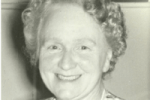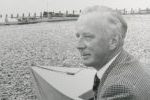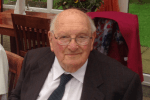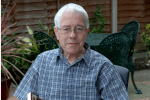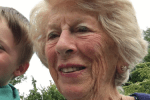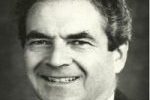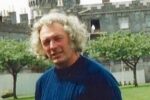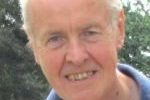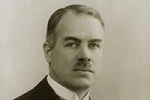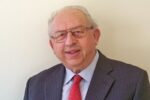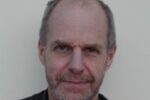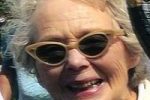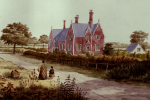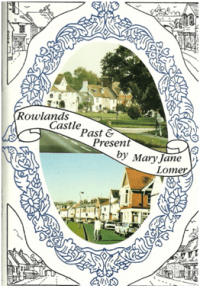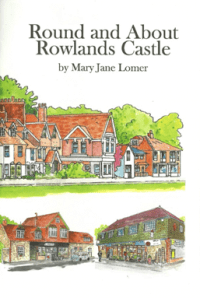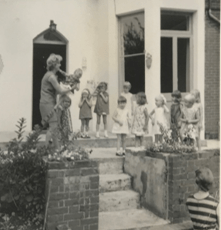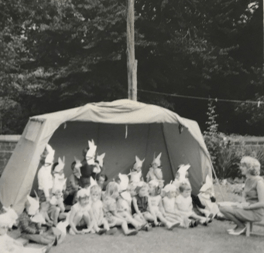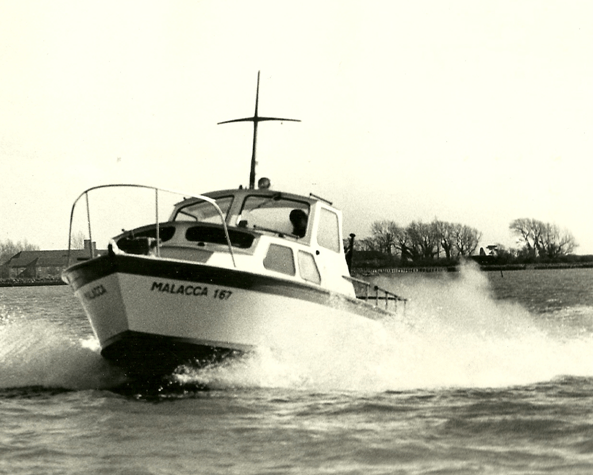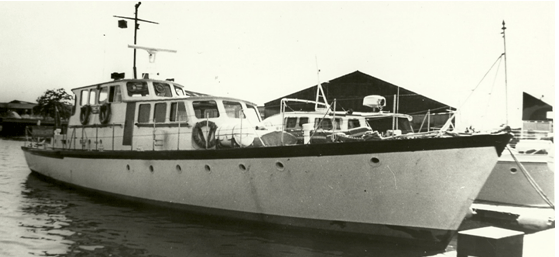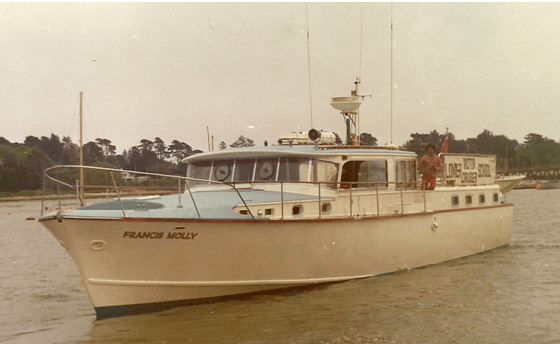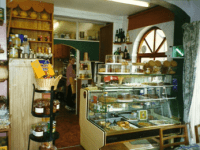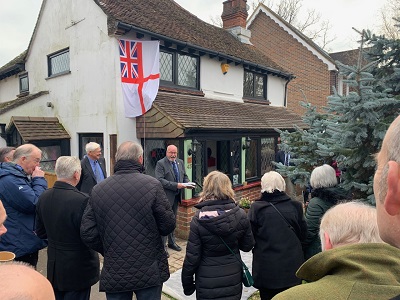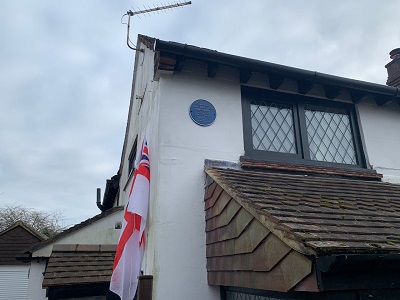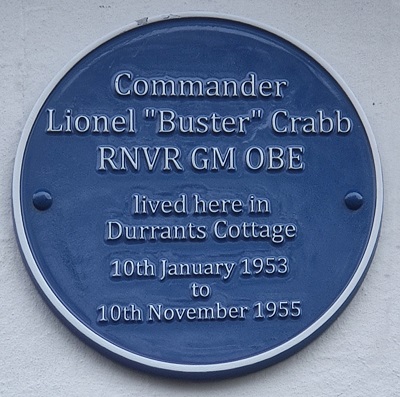Notable Residents
Notable Residents have made a positive contribution to village life by running a local business or shop, serving on a local council, or leading a local club or society, for example.
District Nurse Doris Marshall, 1900-1989
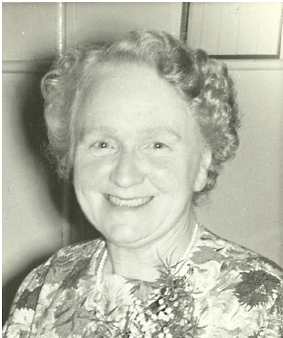
Mrs Gwyneth Ambrose, née Griffiths, provided several photos and a lined booklet with a handwritten account of her mother Doris Marshall’s life after qualifying as a District Nurse which also brought her to Rowlands Castle (copy held in archive). The account is interesting since it describes the role of district nurse in the days of the 1920s, and also an account of an early visit to a local patient stricken with an illness more typical of those times.
Doris’ handwritten narrative starts with her return from studies in Southampton:
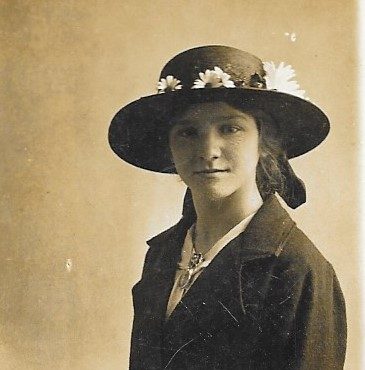
“Feeling like a burst balloon at arriving home and to be with mother again next the question of what to do next just wait and see which was soon realized. There was a vacancy for a District Nurse at Roselands a place I’d never heard of but it was near a railway and not many miles from the sea. Not many days later came a letter from the Secretary of the Nursing Association, these were ladies of a Committee, who interested themselves in the running of the same.
The advice given me was to present myself for an interview on such and such a day and here comes the foretelling which my uncle had spoken to me of that I would go by water to this appointment and then on by rail. The Secretary advised me to do, which would make an enjoyable journey.
Having arrived and seen by others of the Nursing Committee and duly accepted, I was taken to the quarter I would occupy, was a bit taken back it was as far as seen the Coachman’s quarters of an earlier time but quite private the entrance opened into what was once the Harness Room. A table stood in the middle, a sink in one corner and cooking stove in another. There was a short flight of stairs which led to two rooms above, one evidently a sitting room and one a bedroom, fairly comfortable, the ceilings sloped in each room but the height did not bother me, as I was not very tall. Mother of course was with me, and felt concerned that I would be very much on my own. However, there was a large house a little away from the domicile, which contained an Elderly Gentleman. I was therefore on his property and the window of the Sitting Room looked out onto a Village Green and people about continually.
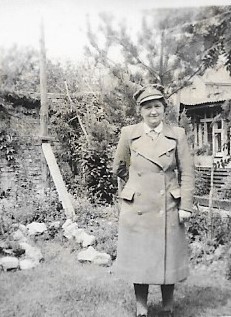
My duties, which would start the following week, as no nurse was in residence. From my house, I would serve the village and north about 4 miles which was furthest I would travel on a bicycle. Of course, it was a tiny village consisting of a few houses around a farm and a quaint old Village Church, also the inevitable Public House which was also very old.
Back at my village there were further houses to the East, South and West. I was presented with the Books and the Register which records the names of mothers who have their babies. One is paid a visit by the higher authority about every three months when they would accompany me on my rounds, and inspect my books.
Nurses would be invited to lectures, if able, at Head Office. It was very welcome as this was often the only chance one saw of one’s colleagues to chat and compare notes. If a District Nurse on a nearby District, one would be conveyed in a bar, which was much more convenient than finding one’s way alone. After these Lectures which were much appreciated by all nurses, time permitting, questions could be asked which in some cases were very enlightening and one would discover that it wasn’t only yourself had problems.
On taking up my duties as District I soon found out that one was looked on as a public body and in some ways rather in awe of, but I’d always liked meeting people and it soon got to my ears that they’d accepted me as their nurse.
My first patient was a young man just across the green where I lived so my first visit was paid that evening. On presenting myself at the door which was opened by an elderly woman I inquired if it was her Son who I was to visit. “Oh yes, do come in, he’s upstairs”. I was taken to flight which led upward and led into a back bedroom which did not look very congenial to say the least and lying in the bed was a very pale young man. Asking questions about his past and present condition I learned he had an operation on his hip, which I was beginning to think had been long overdue. “Why aren’t you up” said I, the reply was “Dr said remain in bed”. He appeared to be in some pain. Leaving later, I really was concerned about him, his meals were taken up to him, no visitors, and a room which left something to be desired. My thoughts were something has got to happen there.”
Mrs Ambrose provided a postscript describing the outcome for Doris of the young man at No 22 The Green. Ted was the son of Chris Griffiths who was station master at Rowlands Castle railway station. Doris was successful in obtaining admission of Chris to a sanatorium in Southampton where he spent two years recovering from tuberculosis.
So it was that in 1930 Doris, who previously lived in the flat adjacent to the current ‘Londis’ stores, married Ted (Edward) Griffiths whom she first met in Rowlands Castle during her first job as a nurse following qualification in Southampton. Ted lived nearly opposite in no 22 The Green. They had one daughter – Gwyneth Ambrose, née Griffiths – who has always lived locally.
Philip McCutchan, 1920 – 1996
Pen Name: Duncan MacNeil, Resident 1953-1963
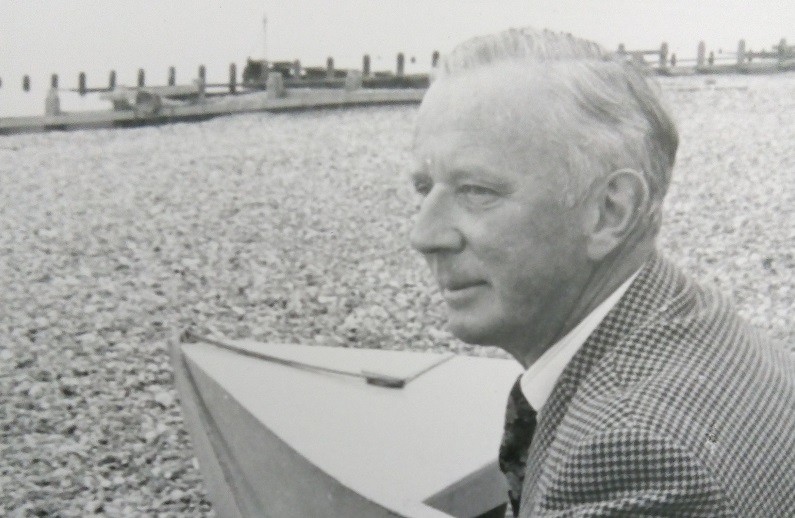
Philip McCutchan, author of over 130 novels, lived in Rowlands Castle from 1953 until 1963. In 1954 with his wife, Elizabeth, he opened a teashop called The Spanish Gipsy which was attached to Myrtle Cottage, 32 The Green.

It was during this time that Philip established his writing career, having five of his “Commander Shaw” novels published, and several radio plays performed by the BBC. Commander Shaw worked for British Intelligence, a tough character with a licence to kill. By 1960 Philip was so well established as a writer that they were able to close the Spanish Gipsy. Philip now worked in the back of the single storey annexe which had housed the teashop. He kept office hours but as an early “home worker” he would break to turn on the wireless to “Listen with Daddy (Mother)” with his young son, Donald. Donald’s early memories of the Spanish Gipsy recall sitting with his feet cooling off in the ice cream freezer during hot summers.
In 1963 the family, which by now included daughter Rosemary, moved to Worthing where they lived until Philip died in 1996.
Early Years
Philip was born in Cambridge in 1920. His childhood was divided between his parents’ home in Portsmouth and his grandparents’ homes, Conington Hall, near Cambridge and Glenlo Abbey in County Galway. Philip’s father was a Master Mariner who achieved his Master’s Ticket under sail and was still serving in the era of the Nuclear Submarine.
Philip always wanted to join the Royal Navy and applied to Dartmouth. However, to his disappointment, he failed the Maths paper for the entrance exam and passed instead into Sandhurst. There he spent one miserable term before war broke out and he decided to fulfil his ambition by joining the Royal Naval Volunteer Reserve as an Ordinary Seaman. He was quickly spotted as officer material and served as a Lieutenant for the remainder of the war. He saw action escorting North Atlantic convoys and in Operation Torch. After the war he spent three years in the Merchant Service making voyages to South Africa, Australia and India before returning to London to take up a post with the Anglo Iranian Oil Company. The City lifestyle did not suit him. So, by now married to Elizabeth, and with his ambition to write becoming stronger, he tried his hand at Prep School Teaching. This experience provided rich material for one of his earliest published novels.
As an Author

Shortly after moving to Worthing Philip began writing Crime fiction and in 1967 he became Chairman of the Crime Writers’ Association.
His greatest successes, however were his historical Naval and Military series. His Naval novels were set in two different periods in history: Lt St Vincent Halfhyde served in Queen Victoria’s Navy, while Lt Cameron’s adventures took place in the second world war, drawing heavily on his own experiences at sea.
The military novels were written under his pseudonym of Duncan MacNeil. This was a strategy suggested by his publisher, who felt that readers would be confused to read such accurate novels about two very different fields by the same author. His eye for detail was so acute that he would receive fan mail from old soldiers who had served on the North West Frontier of India saying they felt he must have served there with them. In reality he had never even been there. The protagonist in these novels was Captain James Ogilvie of the 114th Queen’s Own Royal Strathspeys.
These characters were all brought alive through the pages of Philip’s novels but in a sense, they also became part of the family. His routine was to start at 8am and work until lunchtime tapping out the stories, using two fingers, on a noisy but trusty typewriter: only towards the end of his life did he begin to use an electric typewriter with a word processing facility. Afternoons would be spent editing the previous novel to prepare it for publication. Smoking his pipe or with a cigarette continuously burning, first in the attic room of 32 The Green and later in his study at 107 Portland Road, he produced manuscript after manuscript. His London publishers would say they knew when a “Philip McCutchan” was in the building, as the pages smelled so strongly of smoke. His publishers also described him as “green fingered.” By this they meant he could “just do it”. They knew his writing was so reliable his work would need very little editing. As a result, he had three or four books a year published until the total reached over 130.
In 1990 the Public Lending Right Law was passed, and it quickly proved that he was one of the top most borrowed Library Authors. He had been active in campaigning for authors to be paid a sum of money each time their books were borrowed, and he was delighted when this finally came to fruition.
Philip died in 1996. He never really retired, and his last novel was published in the August after his death.
His Family
Philip was supported in his writing by his wife, Elizabeth Ryan. She was the first reader of every manuscript and gave him constructive criticism as well as proof reading for him. Elizabeth had trained in the days of “Lady Almoners” and took up a post as a Social Worker in the Elderly department of Worthing Hospital when they moved there. She retired in 1990 and continued to live in the house until she died in 2012.
Donald and Rosemary were both born in Northlands Maternity Home in Emsworth, under the care of Rowlands Castle GP, Dr Southam. Donald studied Medicine at Cardiff University, served in the RAMC and became an Orthopaedic Surgeon. He returned to Worthing in 1994 to take up his Consultant post and continues to live there in retirement.
Rosemary trained as a Nurse at Addenbrooke’s hospital. Later she worked at Queen Alexandra Hospital in Cosham, and then taught Nursing at St Richard’s Hospital, Chichester. More recently she taught ‘Care of the Elderly’ at Worthing College. She now lives in Chichester.
Appendix, Some examples of the work of Philip McCutchan
1950s/60s Published by Harrap
The Kid, Whistle and I’ll Come, Hopkinson,
The Devil of Hate
Simon Shard novels
Call For Simon Shard, A Very Big Bang,
Shard Calls The Tune
Writing as Duncan MacNeil (1970s) Reprinted by Severn House under Philip McCutchan name: Ogilvie novels:
The Mullah From Kashmir, The Gates of Kunarja, The Red Daniel
1990s Published by Weidenfeld and Nicholson and re printed by Severn House. Tom Chatto novels:
Tom Chatto Second Mate, Tom Chatto RNR
1960s/70s Published by Hodder and Stoughton
Commander Shaw novels: Gibraltar Road, Bluebolt One,
The Man From Moscow
1980s Published by Hodder and Stoughton
Cameron Novels: Cameron Ordinary Seaman, Cameron’s Troop Lift, Cameron Comes Through
1970s Published by Weidenfeld and Nicholson
Halfhyde novels:
Halfhyde’s Island, The Guns of Arrest, Halfhyde To The Narrows
Non Fiction: Published by Weidenfeld and Nicholson
1976 Tall Ships,
1979 Great Yachts
During the summer of 2018, Donald and Rosemary, Philip McCutchan’s son and daughter, visited the model railway of Rowlands Castle Heritage Centre when on display at Stansted house. They met one of the attendants and offered to draft the above article about him.
First Posted December 2018
Dr Derek Ashworth, 1926 – 2017
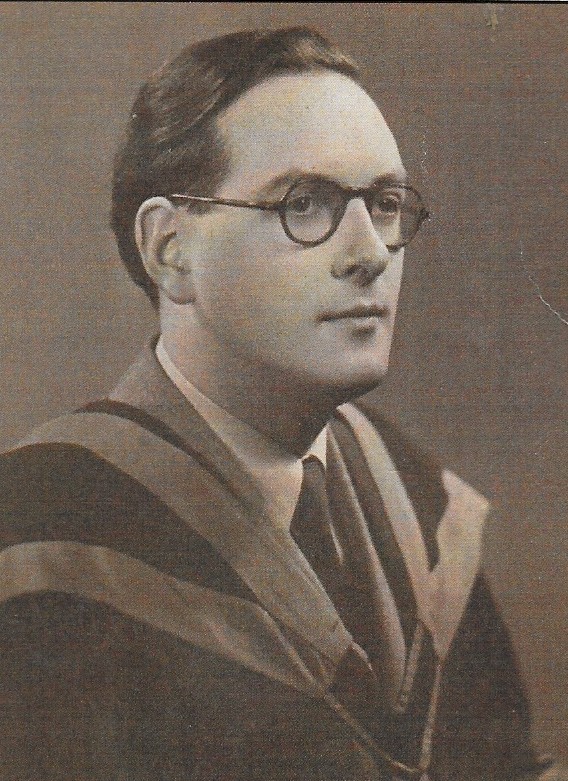
Dr Ashworth came to Rowlands Castle in September 1967 as a general practitioner. Originally, working alone from his own home at 63, Bowes Hill which had a consulting room and a dispensary. He was assisted by a part-time secretary cum dispenser, Mrs Nicholl. There were approximately 700 patients at that time.
He found the work satisfying. He would carry out casualty work himself, such as stitching chain saw injuries which were more common then.
He saw maternity work as a basis for the practice, with a long list of patients. Home visiting was more usual but patients were also more self-supporting. There was a general philosophy that you could not rush anything, which was assisted by a smaller area in which to call.
Changes over time
The practice eventually moved to The Green adjacent to Winnicott’s. Subsequently, he was joined by two partners and a part-time partner. Dr Drew became a partner in 1978. Usually, partners jointly owned the buildings and stock of supplies in the practice, but with financial help from the Government. The Government also oversees the practice. An expanded pharmaceutical service was introduced although it remained skeletal. There were 4,000 patients when he retired. He retired from the practice in 1987. He then practiced for two more years in eastern Canada.
Personal background and family
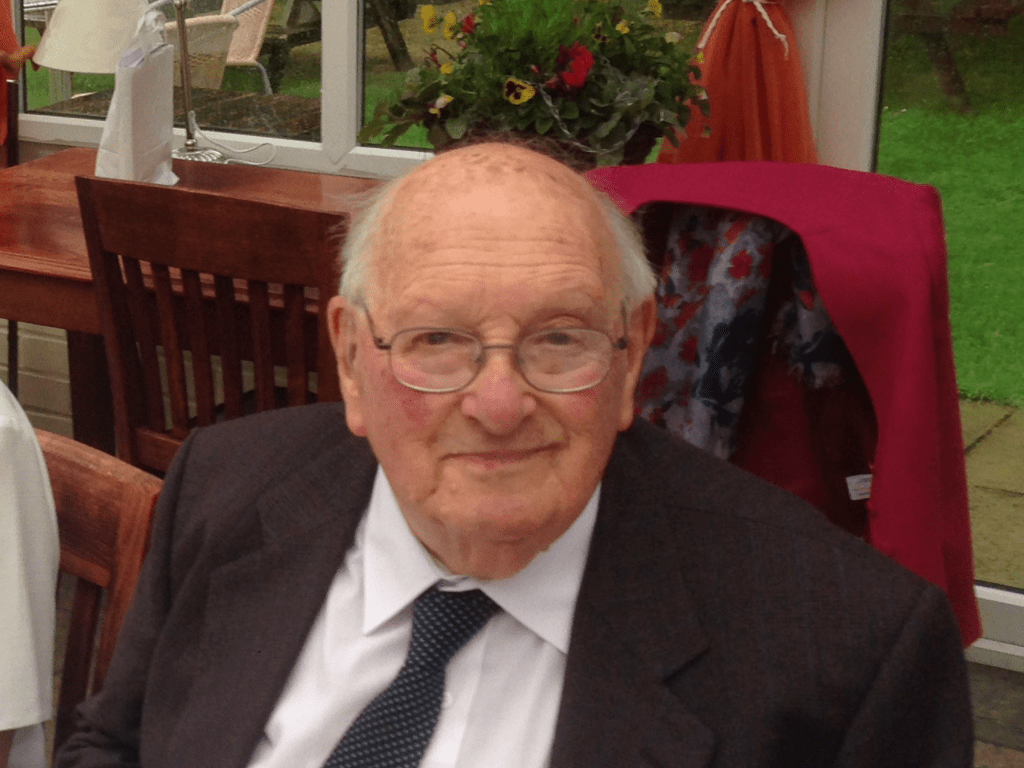
Dr Ashworth believes he had benefitted from a good training which started in 1950 with study for a degree from Manchester University, followed by five and a half years training to meet the qualifying standards of the General Medical Council. He was awarded formal registration as a General Practitioner in 1955.
His initial work was for a practice fifteen miles west of Manchester. Here, the continuing sprawl resulting from development around the City, contributed to heavy winter fogs. His daughter’s health was affected by these fogs and lead his family to move south to protect her health.
His personal interests include classical music of which Hayden was a favourite, for which he was both a pianist and organist. He was involved in music sessions in his home in the Village. He had a lifelong interest in steam engines which were then the main method of traction. Gardening allowed him to keep fit, forced on him by his sedentary profession.
Dr Ashworth has two grown up children – a son and a daughter – and four grandchildren ranging from thirty to twelve years old, who live relatively locally.
Personal Reflections
Dr Ashworth remembers his own training when common things were hammered in most, so that common diseases would be spotted quickly. For example, diseases, such as appendicitis and tuberculosis or rheumatic fever (the latter two now uncommon) could be quickly diagnosed, and doctors should not make a mistake. Conversely, he only saw one case of lock-jaw, and more recent diseases such as Ebola were much more difficult to diagnose.
He believes there is more demand for good medicine nowadays, regardless of the time available. He is concerned at current working practices and thinks that successive days and nights cannot reasonably be worked together. He believes that Government should take this into account, and should be reconsidered by the National Health Service. He claims there is good medicine practised nowadays, but less time for it.
He mentioned that, organisationally, local medical practices are authorised by the Executive Council of the Local Practice Committee (based in Winchester), a body of professional overseers, not necessarily doctors.
The original interview with Dr Ashworth was conducted by Alan Drinkwater on 6thDecember 2016. The initial draft was subsequently reviewed and approved by Dr Ashworth.
Eugene Billam, 1931 – 2015
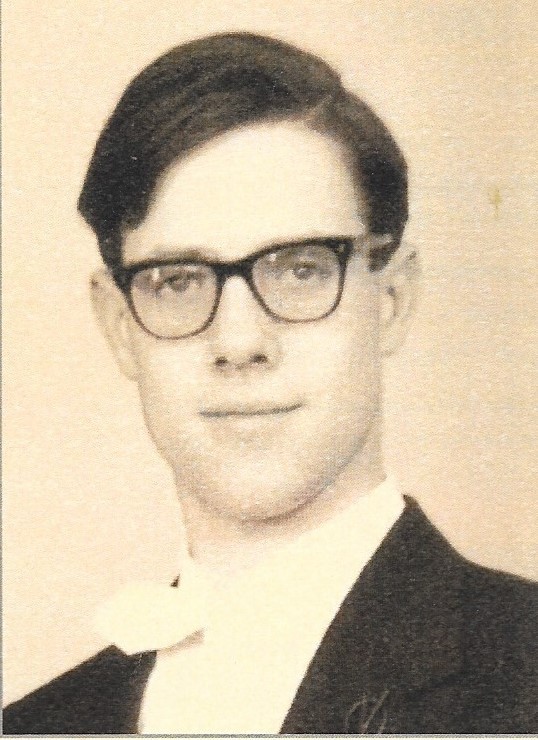
Eugene Raymond Billam was a distinguished research scientist who was also a founder chairman of the Rowlands Castle Association and editor of the RCA Village Magazine.
After attending Woodhouse Ashes grammar school in his native Sheffield, Eugene studied physics at Manchester University. He gained his Masters degree in astrophysics working at Jodrell Bank, Britain’s first radio telescope – where he played cricket for Sir Bernard Lovell’s team. For much of his career, Eugene was a research scientist at the Admiralty Research Establishment on Portsdown Hill – later known as DSTL. Here he led the team that developed Phased Array radar – the radar system that today is used on the current generation of Naval vessels. He spoke regularly at conferences and was granted a patent in his name. After he retired, he carried on working on radar to complete his PhD from Birmingham University.
Early in his career he met his wife to be, Herta. They married in 1960, and had three children, Catherine, Steve and Liz. They started married life in Waterlooville and Widley via San Diego California, before moving to Rowlands Castle in 1968.
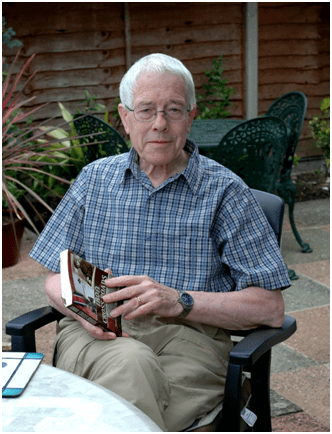
Eugene gave a lot to Rowlands Castle. In 1972, a large housing development was proposed at the end of Wellsworth Lane and Uplands Road. Eugene was part of a group of people who successfully opposed the development. They then decided that Rowlands Castle needed a permanent organisation to protect its interests and the Rowlands Castle Association was born with Eugene as its founder Chairman. He also edited the village magazine for two long periods. The RCA bonfire and fireworks draw people from miles around, but the early fireworks displays were a much smaller affair with Eugene and Frank Philpot literally lighting the blue touch paper to let off fireworks in the Rec.
Eugene’s involvement in the village didn’t stop there. The RCA was offered a sum of money to put on an event for the children of the village so the RCA committee organised the first Rowlands Castle Village Fair. He was one of the group who negotiated with the Parish Council to set up the tennis courts in the recreation ground and the Rowlands Castle Tennis club was born with Eugene as its founder Secretary.
Eugene also had spells as a parish councillor and St John’s School Governor. Eugene was an active Liberal Democrat organiser and election agent for County Councillor Alan Drinkwater and District Councillor David Clegg. He was deeply interested in politics; a big fan of Barack Obama; he even got a letter published in the New York Times, defending his beloved Guardian newspaper. Eugene was a person who enjoyed life.
Living on the edge of the Village overlooking fields, he would sit in the garden with his family after a convivial meal and ask ‘Aren’t we lucky?’ Loved by his friends, Eugene was both interesting and interested. He had long made the discovery that if you asked the right questions, everyone had something interesting to say. He was open and curious about life. Latterly he and Herta travelled widely, including India, China, Syria, Jordan, and Armenia.
There is no doubt that Eugene was delighted when his daughter Catherine, having served on the RCA Committee herself, was elected as Chair of the Association Committee during the celebrations for its 40th anniversary in 22nd September 2012.”
He will be missed by many in the Village who remember him fondly.
(This article was originally written by Richard Milton as an obituary article published in the autumn 2015 issue of the RCA magazine)
Mary Jane Lomer Introduction
This article is based on Mary Jane’s autobiographical writings and several conversations in which she described her own up-bringing, schooling, her marriage to Roger in 1959 and subsequent postings with the Royal Navy, before life in Rowlands Castle.
In person, Mary Jane comes over as an interesting and interested lady who is positive and enthusiastic about what she does. She is proud of her family and of her of her own interests and achievements. One introductory comment she made was “I can’t have nothing to do!”. She also mentioned “I don’t remember stress”. Mary Jane’s early life involved many changes of schools and locations, and she coped well with these and made the most of the opportunities each offered. Her life reads as being ‘an adventure’. Later in our conversation it emerges that one of her proudest moments was attending the award of a MBE to her daughter, Miranda, by the Queen.
Since arriving with her husband Roger in December 1964, Mary Jane has benefitted the local community in many ways. She has published two booklets: ‘Rowlands Castle Past & Present’ of 1988, and later in 2014, ‘Round and About Rowlands Castle’ which introduced the Village and its history to many of us.
The booklets were both written and illustrated by her, and the proceeds used for the benefit of local charities, including Pulmonary Hypertension and, latterly, the Heritage Centre.
She has continually supported charities by producing tea-towels, mats and mugs illustrated by herself. As an active, local member of the Women’s Institute her handiwork contributed to the design and embroidery of a millennial picture of the history of the Village. The embroidery now hangs in the Parish Hall. She also designs flower painting cards for W.I. members who are celebrating their eightieth birthdays.
You may also have benefitted from Mary Jane’s teaching. Mary Jane and Roger spotted Beech House in an estate agents window in Southsea and bought it initially for a nursery school and to bring up their family. Following from this, in 1976 Mary Jane was asked to set up a pre-preparation class as a department of Oakwood Preparatory School near Chichester and ran it for four years.
Later, after Roger’s retirement from the Royal Navy, Beech House was to become the base from which he set up his South Coast Charter Fishing for fishing trips and days out in The Solent. This evolved into the South Coast Motor Cruiser School accredited by the Royal Yachting Association, and ultimately navigation training for naval personal, some from the Middle East.
It was not only trainee naval personnel who benefitted from Mary Jane’s hospitality: in 1982 she opened the Coffee Pot Café on The Green, particularly popular on Sundays when local residents and also cyclists called for “a pot of tea for one, please” before spotting and clearing her selection of cakes. She also taught many teenagers “to cook, add up, and mix with customers”. ‘The Coffee Pot’ closed in 2001, being succeeded on the corner by ‘Tea on The Green’ – more recently renamed the ‘Bumble Bee Café’.
Parents and Early Memories
Mary Jane was born in October 1937 in Shropshire to Mary Skellon and Ewen Williams-Mitchell who had married in Barnes some four years earlier. Ewen was a geologist whose initial jobs were in the United Kingdom but eventually took him, Mary and Mary Jane to Iraq in the Middle East. Ewen lost his father at age six and was educated at a “poor school” in London. His subsequent progress was largely self-taught. Starting work as a geologist, he did well, eventually rising to become the General Manager for the Iraq Petroleum company in the large port of Basrah in Iraq, south of Baghdad but not far from the Persian Gulf.
Both parents were from large extended families with whom Mary Jane kept in touch. Her several cousins lead interesting lives. Joseph, her maternal grandfather, a well-educated gentleman – including Heidelberg University – spent a lot of time in Switzerland, always teaching in preparatory schools.
Early years and Schooling
Of her early years, Mary Jane says:
“My first memories are war orientated, aeroplanes overhead, as we lived in the Midlands, with lots of time in the garden and playing with our little wire-haired terrier. We lived in a bow fronted semi-detached house in Edwinstone, Nottinghamshire where my father worked as a geologist in the oilfields of Ekring.”
“After the war, life continued in a rented cottage at Edingly. We had to fill up a bath in the kitchen, and a loo just up the garden. I had a lovely swing hanging from an apple tree and spent lots of time on my bicycle. Life continued in this rented cottage after the war. We had very pleasant friends around and the severity of the war did not worry me.
In 1943, aged six, I went to a little private school at Mrs Milner’s – eight children with two teachers. It was very happy and countryfied.”
Ewen, her father, worked as a geologist first in Ekring and later in Wiltshire where the family took a rented cottage at East Marin.
“I started at the Leehurst Convent in Salisbury and was soon able to walk to the bus stop and get the bus myself – after all I was quite grown up by then, at least nine! I made my first communion there on 6th December 1946, white dress and all.”
They subsequently moved to the Old mill at West Harnham which was owned and run as a tea shop by a lady friend named Ross and her daughter Elisabeth, the same age, who also became a great friend.
”We used to fish for tiddlers in the river, and swim and paddle. The tea shop was always busy and I think that was where I got my love of baking.”
Her Father Ewen’s, Work in Iraq
Her father then got a job as a field geologist in Ain Zalah in north Iraq, with the Iraq petroleum Company. This was a step up, and her parents decided that their family would follow him out there when he was settled. In the meantime, Mary Jane and her mother spent the winter in a rented a bungalow in west Worthing, changing schools to the Worthing Convent.
Mary Jane writes of the trip out to Iraq where her family became ‘ex-patriates’, a way of life common to many British people working across the British Commonwealth:
“What an exciting trip that was! We had various injections which made us quite bad for 24 hours, and packed clothes that we might need. We took the train to London and then stayed at the Kensington Palace Hotel, so smart that we were amazed. We boarded a Pan American Clipper for Malta. It was so exciting to fly into Malta (where one day I would return) and the one thing I remember was you did not need coupons for sweets there. We refuelled and then flew on to Haifa (Israel). We had no idea what would greet us when we were there except that it would be very hot. It certainly was when we arrived in Haifa and transferred to a small Dragon Rapide biplane. We flew up to the pipeline stopping at each oil camp until we arrived in Kirkuk where my father was waiting for us with his hillman car, no air-conditioning… boy was it hot! We did not have very much stuff with us, but the IPC provided everything needed from sheets, towels, plates, cutlery for a completely furnished three-bedroom bungalow, a lovely home. Being an oil camp there was a wire mesh fence around the bungalows, but it had holes and the camels would come up the garden and eat my mother’s favourite flowers.
I was home educated in the camps at Ain-Zalah by the Parents National Educational Union (PNEU) who sent books for the curriculum.
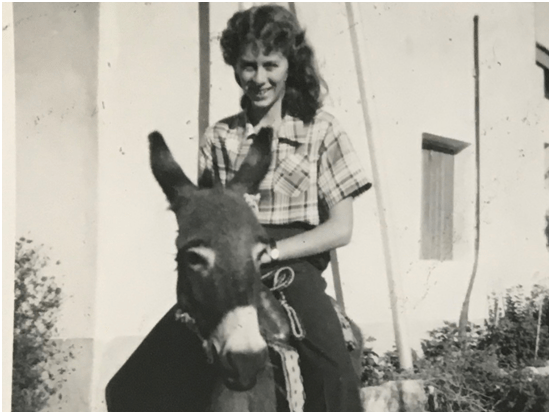
Time passed happily in the camp but in 1948 my parents decided that I needed to go to school, so I was sent to the American Community School in Beirut – set up for the education of children of the American/Arabian Oil Company staff.
Beirut in 1948 was a wonderful thriving city and I soon settled in…and really loved living in Lebanon. It was like no other place I had been to, and so unspoilt… I liked to find the roads along the seafront. But still nothing compares with the corniche in Beirut which used to stretch all the way around the city waterfront. Talking of Beirut, I cannot smell the herb Basil without being reminded of school trips up the mountain lanes of Lebanon.
However, when I flew back home to the oil camp Ain Zalah, with an American accent my parents decided to send me to a convent in Surrey that they had chosen for my further education.
A company called Universal Aunts met me at the airport and took me to the train for Effingham Junction. It was snowing and the old nun who drove me up to the convent, had driven during the war and still drove as if she was dodging bombs, a scary introduction to the school.
Leaving school in 1955 I returned to Iraq this time to Basrah where my father was then the managing director of the Basrah Petroleum Company. I was then part of the amusingly called ‘fishing fleet’ of unattached girls who were invited onboard naval ships when they came up the Shatt Al Arab river showing the British flag. A company car took me into the souk where the French Convent School was situated and I started teaching the entry class there, the children being from many different nationalities. We didn’t have much equipment cowrie shells and little blackboards with chalk and a few books, but they all learnt to read.”
Meeting and marrying Roger: postings with the Navy
“I had sandfly fever when H.M.S. Loch Alvie visited Basrah but my mother having gone to their cocktail party onboard invited a group to play tennis at our local court. Roger Lomer was among the guests and if you believe in love at first sight it was that for both of us.
We met again several times and carried on a correspondence until I left Iraq in a hurry after the murder of the young King Feisal. We were under a curfew and once were out too late and were stopped by a lorry filled with rifle waving soldiers. Luckily, we had a home near Hastings so were able to go there where I attended the local art school before applying to train as an infant teacher at the Maria Assumpta Training College in Kensington Square from 1958-1960, where I received a Distinction in the Practice of Education.
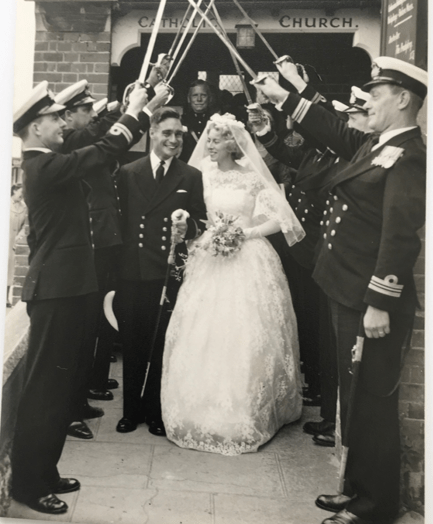
Roger was posted to West Hartlepool to oversee a frigate’s refit but came to see me every weekend. We were married in 1959 and he was posted to Malta onboard H.M.S. Trafalgar I was able to join him at the end of my training and we rented a flat in Sliema and bought a little sports car. Grammar at a local girls school in the afternoons.
Roger was then posted in June 1961 to Gibraltar to oversee the refit of a frigate. We bought a grey Sunbeam Rapier car with a red roof and set off on our next adventure, camping through France and Spain. Our first flat was in a Cable and Wireless building overlooking the army barracks where soldiers drilled all day. As water was short in Gib, we had a salt water tap as well as the cold tap. I managed to make our first cup of tea with the salt water which was very amusing. We later found a delightful flat in the centre of town before moving again.
Roger bought himself a Lambretta scooter leaving the car for me to travel to work teaching in the local Loretto Convent. There I was put in charge of helping the other infant teachers with new ideas and teaching methods. It was all great fun and as most of the pupils spoke Spanish quite a challenge.
As I have always loved painting, I did a lot of local views and went into Spain with the Governor’s wife on painting expeditions. Soon I had enough paintings to have an exhibition and this was possible when we moved to a naval flat in the Old Naval Hospital complex which had a “cave” beneath It. I still have friends who tell me one of my paintings is still hanging in their house.
We made many friends; visited Spain a lot when the border was open’, rode horses along the beach, but stopped as I was pregnant producing our son Chris in July 1963 in the Royal Naval Hospital. It was luxurious in those days with a ten day stay in the hospital.
Before starting teaching again in September – when the nuns watched over the baby while I taught – we had taken a trip to Morocco and got as far as Marrakesh, staying in wonderful hotels, and feeding Chris behind carpets in the souk. Later we drove to Portugal to visit Portuguese naval friends, taking Chris with us.
All too soon the posting came to an end and we returned to the U.K. Having an idea that I would like to start my own nursery school, I bought 24 small Spanish Children’s chairs and sent them back to the UK onboard the frigate. Our car was lashed to the deck which didn’t do it any good, and it was never the same.
We started house-hunting but sadly my mother died shortly after our return, leaving my father to sell his house and move in with us in Rowlands Castle in December 1964.

“When we found Beech House in the estate agents window in Southsea, we were looking for a suitable home to run a nursery school and bring up a family. Tumbledown and a wreck, the House filled the criteria even though it was dilapidated and needed doing up. My father having had polio in 1926 and told he would never walk again proved everyone wrong, taught himself to walk and learnt many skills, so could turn his hand to many jobs even if he was sitting down doing it. He with the help of local handyman Mr Harding and others, fitted out the house ready for the nursery school. My father lived with us until flying off to South Africa, returning and marrying his best friend’s widow from Basrah in 1968.”
Husband Roger’s Business
“Meanwhile Roger did two more tours with the navy: nine months in the far and Middle East finally leaving the navy when I was expecting our second child. He set up his South Coast Charter Fishing business and subsequent training courses.
We used his naval money to have a 27’ single screw motor cruiser built at Hamble and with moorings at Sweare Deep by the Bridge to Hayling Island, set up South Coast Charter Fishing taking fishermen out beyond the Isle of Wight on day trips. This grew to South Coast Motor Cruiser School accredited by the Royal Yachting Association, when Roger discovered how many expensive Motor Cruiser owners had no idea how to handle their craft.
Having visited many Arab countries Roger was very taken by the Middle Eastern Area and having contact with various boat yards at Hamble discovered that there was a requirement to train the crews who would be handing the boats when sold to their governments. His previous motor cruiser schools held him in good stead to take on groups of foreign marine students. Buying two more boats he was then able to offer courses to foreign naval and coastal personnel. The first students arrived from Brunei in 1974 and were followed by groups from Bahrain, Quatar, United Arab Emirates and Saudi Arabia’s oil company ARAMCO. He then called the company Lomer Seamanship & Navigation Centre.
This changed the use of Beech House and we soon had students living with us for three to six-month courses and had to move the Centre to Annesley House, Queens Crescent, Southsea, and employed five ex naval officers to lecture and teach boat handling on our three motor boats moored at Hamble.
Life was very busy as I bought all the provision for the students and oversaw their wellbeing. Not easy when each weekend they invited ‘friends’ from London to join them, and all the food was used by the visitors.”
Roger’s business was based on an idea he had while patrolling the Malacca Strait on board a Royal Navy frigate: to set up a Motor Cruiser School. Roger felt strongly about safety afloat which became a main driving force behind the courses. An estimated 90 percent of small boat accidents could be prevented by proper equipment and how to use it, and what to do in emergencies. Although there were about 150 sailing schools in existence, there was no provision for beginners and new owners. The school started with a one-day course, subsequently extended to three days, for teaching boat handling and seamanship and navigation. The school was soon fully booked up.
Following recognition by the Royal Yachting Association, courses were up to RYA certificate standard, with both residential and non-residential classes eventually lasting for a weekend, five- or seven-days duration. When more widely known, applications increased quickly with weekend introductory courses on such subjects as buoyancy, ‘rule of the road’ mooring and anchoring, safety at sea and navigation. Subsequently two other boats were purchased, as also was further accommodation in Portsmouth.
Beech House which had been restored by Mary-Jane and her father, provided ample and spacious accommodation for the residential courses, with a lecture room and separate sitting room for students. It had already been established as a nursery school for 40 pre-school children. Run by Mary-Jane.
Meanwhile, The Lomer Seamanship & Navigation Centre ended trading when most countries found that their personnel who had completed our courses were able to train their own boat handlers.

After twenty-two years in the Navy rising to Lieutenant Commander, Roger also turned his hand to writing novels. At age 67, just after a double heart-valve operation. He published ‘Vendetta’.
Teaching and Art
“Life for a naval wife in those days was quite different to today and one was left on your own to cope with all the house and business jobs. None of the “girls’ nights out” of today but we managed to entertain ourselves. The nursery School grew and grew, and I stayed open through the summer holidays with several Mums helping me.
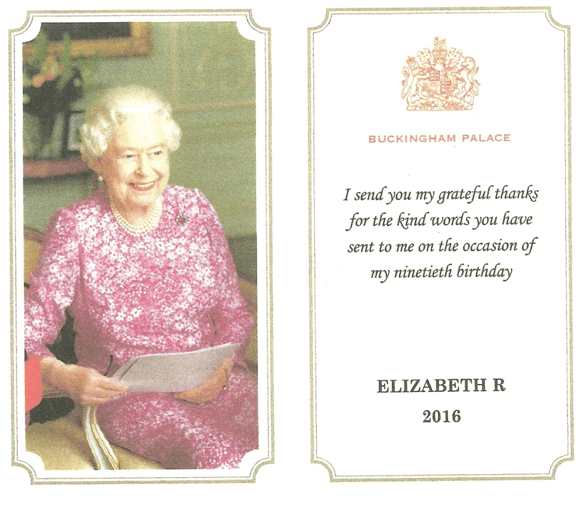
Being a member of the Women’s Institute and serving on the Hampshire Art Sub Committee widened my experience. I was asked by the local W.I group to design a card wishing the Queen Happy 90th Birthday and received a thank you card with a picture of the Queen who had commanded a lady in waiting to write and thank me.
The local W.I. Members embroidered a millennial picture of my design of the village which hangs in the Parish Hall. I was fascinated by the history of the village and painting views, taking children to Scouts, Brownies, swimming and Dancing classes. We were always kept busy.
In 1976 I was asked by The Headmaster of Oakwood Prep School near Chichester to set up a pre- prep class. I ran the department for four years and it grew into a self- contained Pre- Prep with several classes until Roger needed me to help him with the overseas students.”
Booklets
“In 1988 I produced my first booklet on the history of the village. With the second book I was able to raise money for Pulmonary Hypertension. I also produced tea towels of the village and I have now designed a tea towel of the meeting places in Rowlands Castle, now on sale”
Family
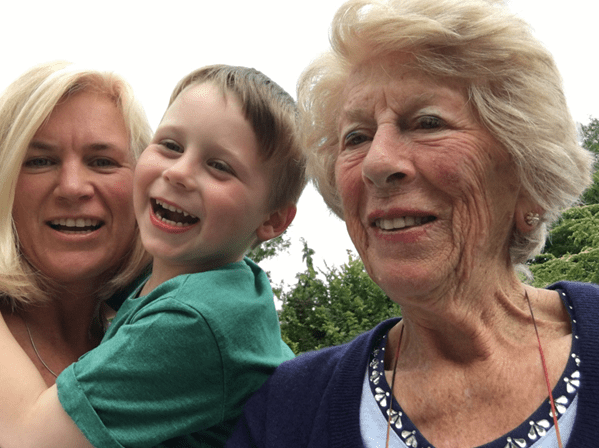
Chris
Running through our life in the U.K. we spent many camping holidays in France and in the 70s purchased a mobile home near Frejus in France. After a year working up at Stansted helping Mr Harding in the woods, Chris our son, at age 18, decided to take his racing cycle to France to race. He stayed with friends, did well racing but decided it was too risky as even in those days you were asked to take supplements etc. He then worked in MacDonald’s in Toulouse and became the manager. Then he tried Decathlon. Chris worked his way through several companies and now advises companies on their pay schemes in Europe. He has three children and has just had a amazing house built where his French wife is the mayors adjutant.”
Miranda
“Our daughter Miranda went to school in Midhurst, travelled everywhere while following a career in dietetics in the N.H.S. Now a specialist in Crohn’s disease and Irritable Bowel disease, she was awarded an M.B.E in the Queens 90th Birthday celebrations. She is married to solicitor John Wilson and they have a son called Edward and live in a wonderful house in the beautiful Surrey countryside.”
The Coffee Pot Café
At the same time the Coffee Pot Café was open every day. It was very popular on Sundays when all the cyclists came in for “A pot of tea for one please”. Seeing our selection of cakes they ate everything in sight. I taught many teenagers to cook, add up and mix with customers. Many went on to great careers and family, some life still living in the village.
When I closed the shop in August 2001 it was followed by ‘Tea on the Green’ at the corner. In 2018, Katy Hall – Robin Hall’s daughter – who had worked for me in the Coffee Pot, has taken over the building as The ‘Bumble Bee Café’. She is so glad to be back where she grew up, and everyone is so pleased to see her. Katy had attended my nursery school, and, as a teenager, her first job was at the ‘Coffee Pot’.
In Retirement
Roger had heart surgery in 1989 but continued to advise several boat yards on training, and he retired in the mid-nineties.
The Coffee Pot continued until August 2001 when we decided to go and live in a beachside property on Hayling Island. I took up glass engraving which was a wonderful experience, but I think it could had contributed to my pulmonary hypertension as the glass dust which, however you tried, was still in the air, particularly when I used the drill on the glass. I had been breathless for some time and discovered that I had a condition called Pulmonary Hypertension where the arteries in the lungs are unable to function causing fatigue and lack of energy. Luckily Hammersmith Hospital has a special unit for this condition and with their care I am able to lead a quiet life as long as I don’t try to do too many activities.
I was able to continue painting on Hayling and raised money for the Pulmonary Hypertension charity by designing tea towels, mats and mugs for sale at Hayling Hardware. I continued to be a member of the Rowlands Castle W.I. and have enjoyed being on the committee helping at jumble sales and many other activities.
When Roger died in 2011, I was keen to return to the village. Edwina Butler who lived at No 70 The Green had worked for me in the Coffee Pot along with Freda Stafford, Helen Atkinson and Sandra King, went into a home and purely by chance I saw Edwina’s brother outside her house and asked him if I could rent the property. I moved in on December 1st, 2012, and bought the property two years later. Such a gem of a cottage with an interesting history.
I have a cupboard full of children’s stories with illustrations that I would like to work on, but my energy levels are not what they used to be. With so many paintings I also intend to have an exhibition one day.
Editor: Placed on Website: March 2019
Alan Drinkwater 1939 –
Trustee and founder member of Rowlands Castle Heritage Centre
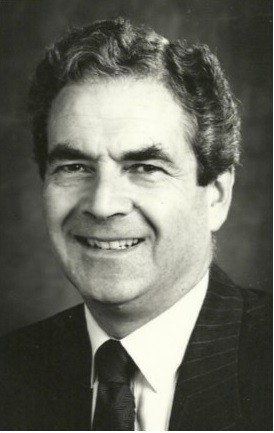
Opportunities, usually later in life and during retirement, can allow us to engage in a ‘portfolio’ of activities proving to be both constructive and pleasurable, including co-operating with other residents with different perspectives and motivations of their own. I have presumed to describe my own experiences of volunteering and public office in Rowlands Castle and elsewhere to provide examples. I strongly encourage others to follow suit!
Volunteering can take as much or as little time and interest as available. I took up local opportunities to help in preparing Parish Plans, plus founding and developing the Heritage Centre, from both of which have I have learned more about our community, its environment and heritage. In the Heritage Centre we have tried to formulate our own policy for ‘Volunteering in Practice’.
Being elected to Hampshire County Council, I found most stimulating, as was my other public appointment to the Environment Agency. Although offering limited allowances, but usually paying some costs, volunteering can provide personal satisfaction, and enable one to ‘make a difference’.
Volunteering for Public Service with Hampshire County Council – 1985
In 1985 I was elected to Hampshire County Council ‘Catherington Division’ as a Liberal Democrat. At the time, the Division included the three local parishes of Horndean, Clanfield and Rowlands Castle. I struggled to be re-elected in 1989, but I achieved another sound majority in 1993, serving for three terms, a total of twelve years.
During my last four years of public office, the Liberal Democrats were returned as the largest party and agreed to run the administration of the Council jointly with the Labour Party. This provided opportunities to set the agenda, by chairing committees and panels.
On election, Council members benefitted from briefings and tours of the County – much information to absorb, being a large, historic County, with a population of over a million residents. The formal briefings covered both the Council’s legal and discretionary roles and responsibilities.
Additionally, focussing on the local community, I considered it important to set my own priorities, deciding what I wanted to achieve during each term of office across the three Parishes. I saw my goals as a hierarchy: for each ‘parish’, ‘division’, ‘county’, and ‘regional’ level:
- Each of the three parishes: A major focus on highways
- Catherington Division as a whole: Horndean Community School
- The County Council as a whole: South Hampshire Rapid Transit
- Regionally, in South East England: SERPLAN, and Solent Forum
A more detailed description of my goals and steps to achieve them is offered in the Appendix, below. Throughout the twelve years, I served on the Planning & Transportation Committee. I was on the Education Committee for two years, the Police Authority for one term, and the key Policy and Resources Committee for most of my last term.
Overall, serving on the County Council provided possibly the most fulfilling experience of my life. I enjoyed my time, sitting on many committees and panels, and gaining satisfaction from working informally with the officers. In 1997, however, I decided to stand down.
Volunteering for Public Appointments – 1997
Shortly after standing down from the County Council, I applied and was appointed by the former MAFF (now Department for the Environment) to the Southern Region Flood Defence Committee of the Environment Agency. I served for eight years. I was also asked to chair the Hampshire & Isle of Wight Local Flood Defence Committee. The Agency’s regional office was in Worthing.
The experience was most interesting, focussing on ‘water’ as a critical issue in the South East; protecting groundwater supplies, watercourses, rivers and reservoirs; and flood management of both rivers and coasts. Environmental improvements were also addressed as a high priority.
At the same time, I continued with other voluntary activities on the Council of the Solent Protection Society, and as a trustee of CPRE Hampshire (Campaign for the Protection of Rural England), both having an environmental focus.
In 1999, possibly due to my general experiences on the County Council, I was honoured to be invited to become the first President of the Rowlands Castle Association, a non-executive role. I was subsequently re-appointed annually, and stood down in 2021.”
Volunteering in the Parish – 2005
‘Retirement’ finally arrived after my Environment Agency duties. I volunteered to be a member of the project teams that drafted the Parish Plan published in 2008, and later the Local Landscape Character Assessment published in 2012.
Both were initiated by the Parish Council as ‘arms-length activities’, drafted by independent groups although including representatives of both the Parish Council and Rowlands Castle Association.
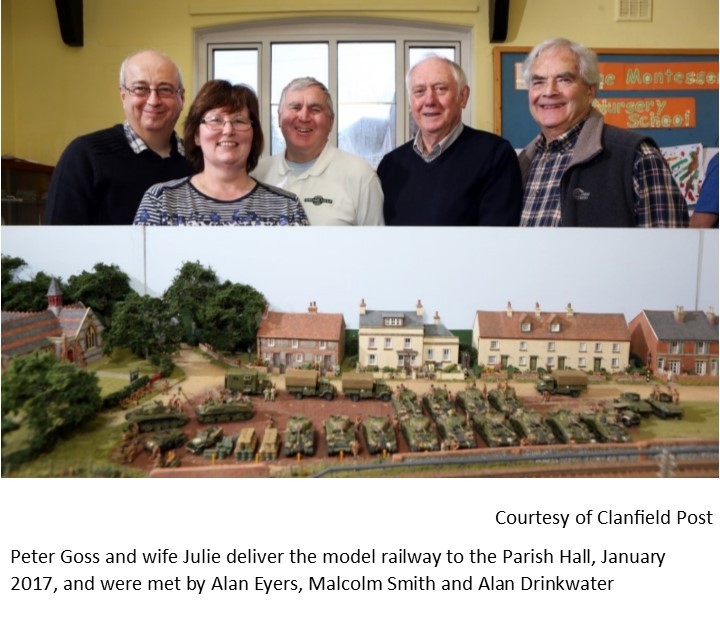
In 2015, Rowlands Castle Heritage Centre became my most engrossing activity. Initially this focussed on the purchase of the iconic model railway built by Peter Goss, showing the Village preparing for the Normandy Landings on D-Day, in June of 1946. Peter Goss had offered the model for sale to the village.
In addition to buying the model railway, a group of volunteers decided to create a Heritage Centre which involved launching this website as a virtual museum, registering as a charity, and searching for a building to serve as a museum, or even as a ‘community hub’. A lease on the railway station is still being considered
Contacts for Voluntary Organisations in Rowlands Castle
If you are interested in becoming a volunteer, the following is a list of organisations in Rowlands Castle which provide opportunities for the whole local population, rather than a specific group or a more limited range of activities. Residents interested in volunteering are encouraged to discuss opportunities with the chairperson, clerk or secretary, or any member.
Appendix 1
Volunteering: Public Responsibilities as an elected Representative
The appendix is intended to provide more detail on the main activities I engaged in during my twelve years as the local elected representative on Hampshire County Council, when I believe that I did ‘make a difference’!
The main aspects of being a representative were keeping in touch with the local community – both individual residents and organisations – as well as to take part in wider County Council business through committee work and in discussion with fellow members and officers. To focus my attention and effort, I set my own priorities as described below. They embrace planning matters including housing numbers and related issues of traffic and highways.
Highways & Footways My initial focus in Rowlands Castle was on improving footways to safeguard pedestrians. The first was along the last few yards of Links Lane to The Green and past the United Reformed Church, where pedestrians once walked in the road, to the Parish Hall and Recreation Ground.
Later, I asked whether footways were achievable through the Railway Arches by The Castle Inn and later still, under the arch at Dean Lane End.Thirdly, both Castle Road and Finchdean Road had long footways only just above road level, so I sought to make them safer by having them rekerbed and rebuilt along their entire lengths.
I also sought to improve traffic flow from Redhill Road into Manor Lodge and Durrants Roads, for which the twin, mini roundabouts were proposed, and then implemented. (Now under review again, as traffic continues to increase).
Car parking, particularly around The Green, was also an issue in the 1980s, and white and yellow lines were progressively introduced.
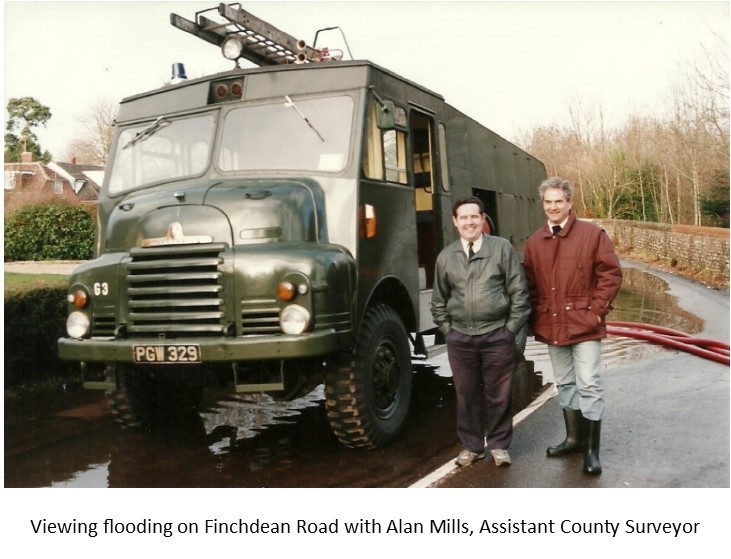
A major scheme was undertaken during my last term of office, to improve Durrants Bends (B2149) by improving sight lines, mitigating an adverse camber on the main bend, and introducing a cycle way. This was followed by a scheme to improve Manor Lodge Road north through Havant Thicket to address humps and bumps caused by seasonal movement in the clay base. Stabilisation was achieved by laying ‘geo-membrane’ over foundations before relaying the road surface.
Horndean Community School, now known as Horndean Technology College, was my major focus at ‘Division’ level. It was the largest ‘establishment’ in the Division, eventually growing to over 1,500 pupils. So, any improvements would benefit a large section of the community. The School had already outgrown its original buildings and could not offer ‘whole school assemblies’, for example. Further buildings were necessary. I was also interested in the better use of school buildings during evenings, weekends and holidays for the benefit of the wider community. At that time, The County Council was approving designation of ‘community schools’ whereby a school would receive additional funding for community officers to arrange out-of-hours sports and social activities.
As a councillor, I was required to appoint five governors to the governing body of the School, and I could also appoint myself. I briefed governor candidates on the proposal for ‘community school’ status. Similarly, when appointing a new headteacher, I was able to brief other councillors and officers in the selection process, so that a new headteacher with community school experience could be appointed. The new head teacher conducted the required researches, obtained the necessary approvals for community school status. Community officers were duly appointed . This opened the way for construction of a new multi-purpose hall with social facilities to meet both school and community needs. I asked to sit on the Education Committee to seek funding for the hall. Later, I enjoyed several music concerts in this hall.
I eventually served as a governor of the School for sixteen years, covering appointments of three headteachers, and witnessed growth of pupil numbers to nearly two thousand. At that time, the School had a Sixth Form for which a dedicated classroom block was built.
By way of addendum, there were eight schools in the electoral division including the Community School: two Middle Schools, four First Schools and one Primary School. At that time, I was also responsible for appointing LEA governors to each school, the number depending on the size of the school. I maintained contact with head teachers, particularly when several new building projects were involved – the County Council was also the ‘landlord’ as well as the ‘Education Authority’.

South Hampshire Rapid Transit – was a Super Tram project from Fareham to Gosport, then under the harbour in a ‘cut and cover’ tunnel to Portsmouth.
During my third term of office, the Liberal Democrats formed the Council’s administration: as the only Liberal Democrat who had served on the previous Super Tram Panel, I was asked to chair the new Panel. I was willing to do this provided it was agreed to implement the tram project which had demonstrated the best ‘cost/benefit ratio’. The project from Fareham to Portsmouth Centre had the best case as it ran along a well populated but traffic congested corridor. £500,000 would be needed each year to fund the development team and relevant studies, so the County budget was adjusted accordingly. I was to chair a newly created Joint-Members Super Tram Panel with councillors from the other three councils involved – Portsmouth, Fareham and Gosport – aiming to ensure support for the scheme across all four.
By 1997 at the time I stood down from the Council, proposals for the scheme had been prepared and agreed, and the Department for Transport had given its approval, with some Government funding being available.
However, later in 1997 both Portsmouth and Southampton became independent ‘unitary authorities’, no longer part of the County Council. This required that the Rapid Transit scheme should be resubmitted as a joint project between the County and newly independent Portsmouth City Council. During the following four years, the scheme was again approved, and the two Councils invited consortia to ‘plan, construct, operate, maintain and fund’ the scheme. One consortium was being selected to finalise arrangements when the Government announced that two new large aircraft carriers would be built, to be based in Portsmouth Harbour. For the tram system, this would require a deeper tunnel, and revision of ramps and portals for the trams. Councils could not agree the additional costs which lead to the scheme’s demise.
Apart from existence of detailed plans, one positive outcome was the introduction of a fast bus service with exclusive access along the former railway embankment from Gosport towards Fareham, alleviating some traffic congestion. I still regret that such a modern transport system was not successfully implemented.
SERPLAN: During my third term of office, I volunteered to be the third Councillor representative to SERPLAN – the London and South East Regional Planning Conference – which met three times a year in London to consider planning matters and draft the regional planning guidance (RPG5) for submission to the Government. SERPLAN was a voluntary association of representatives from County, Unitary and District Councils in the greater South East – from Essex to Berkshire and across to Kent, with the London Boroughs represented by LPAC – the London Planning Advisory Committee.
SERPLAN was serviced by a small group of planning officers based in an office in London, ‘supervised’ by nominated County Chief Executives and Planning Officers. SERPLAN conferences were chaired by Lord Carnarvon, the 7th Earl, a Hampshire peer who lived at Highclere House. He sat on the cross benches of the House of Lords so was regarded as being politically impartial. Responsibility for arranging conference business was carried out by a Members Policy Group (MPG) of some thirty councillors which I attended on behalf of Hampshire.
Many members were dissatisfied with the way the chairman of the MPG was elected for the first year. I was then supported in standing in the second year, and duly elected, and re-elected in the two subsequent years. This was the highest status position that I achieved during my service. I was complimented on the way I ran the MPG meetings in preparations for full Conference! I also believe that I moderated the debate on housing numbers – key planning criteria for regional plans – by challenging the then current ‘Predict and Provide’ formula, and a more appropriate ‘Plan, Manage and Provide’ process was subsequently considered.
Solent Forum was an idea that I pursued during my second term of office – noting that a ‘forum’ was referred to in one of the Council’s own booklets. The Solent seaway and estuaries below low tide do not come under the jurisdiction of any council, although the Crown Commissioners have a role for seabed activities. The seaway is intensively used by a wide variety of interests: The Royal Navy, commercial shipping, recreational sailing, fishermen, diving groups, environmental groups, and recreational activities.
I tabled a motion to full council: ‘to initiate discussions with interested bodies for the creation of a consultative forum for The Solent’. While a vote on a new topic risks being lost, I hoped that the Chairman would offer to refer it back to the officers for detailed consideration, and to report in due course. I happily agreed that it should be ‘referred back’. Two years later, a ‘Solent Forum’ was proposed and then implemented, chaired by a respected local person, to discuss (but not decide) upon matters of common interest. During my last four years on the Council, I became the council’s representative at the twice-yearly Forum meetings.
The Forum has developed as a respected institution for consultation on the environment, with several working committees. It has since been emulated by the Dorset Coastal Forum, (‘the Jurassic Coast’ – a World Heritage Site). While not claiming responsibility for its progress, I am proud that I was able to launch the concept.
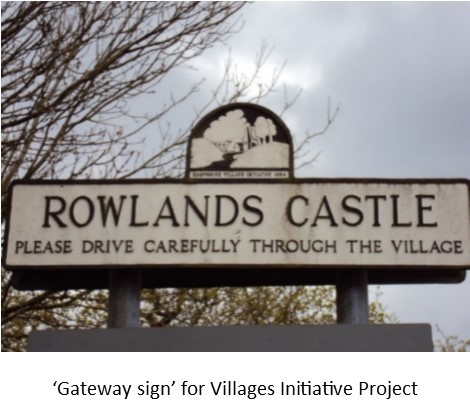
The Panel was one of the working groups that I was invited to chair during my last four years of office. It considered modest schemes to enhance the environment of country villages – by revising road layout, undergrounding unsightly telephone wires, introducing rustic features. It came as a bonus when the officers asked whether Rowlands Castle should be included, focussing on a review and improvements to The Green – a designated ‘Conservation Area’. A detailed scheme was developed, presented to the Parish Council, and subsequently implemented, hence the ‘gateway’ signs.
Some Conclusions: My service on the Council was most fulfilling and enjoyable. I felt that I had contributed to the community in many ways. This would not have been possible without the readiness of Joan, my wife, to bear most responsibility for bringing up two teenage boys during my frequent absences. I only became more aware of my over-indulgence later in life!
My tenure of office was also facilitated by a group of local Liberal Democrat activists who kept me grounded on local matters and provided much needed support during times of elections.
Appendix 2
Personal Background
I was born in 1939, and lived in Kenton, Middlesex, near a well-established secondary school – Harrow County Grammar School. I entered the School having sat the eleven plus examination, and studied Geography, Economics and French to GCE ‘A’ Level. The School had a variety of clubs, societies and a cadet force, which helped in gaining entry to university.
By the time I left school in 1957, I had been offered a place at Merton College, Oxford to read Geography in 1959. But in September 1957, I was called-up for my National Service, joining the Royal Corps of Signals, was commissioned and posted to Cyprus for eighteen months. I duly went up to Merton in 1959 and graduated in 1962.
My first job was with United Steel Companies Ltd in Sheffield, initially as a ‘graduate trainee’, before becoming a sales clerk at a nearby steelworks in Stocksbridge. I resigned after eighteen months to study for the Diploma in Personnel Management at the London School of Economics.
From 1965 onwards, my career was in Personnel Management with Esso Petroleum Company, Colgate-Palmolive and lastly IBM UK. I joined IBM in July 1969, an especially significant year as Joan and I were married in the May.
Overall, I enjoyed my career of twenty-two years with IBM working in various Personnel functions, and lastly as Personnel Research Manager. I benefitted from a two-year secondment to the teaching staff of Henley Business School, where I also registered for a doctorate into ‘industrial democracy’ (finally graduating in 1984). The highlight in 1980, however, was a three-year assignment to IBM Europe where I learned about other countries’ industrial relations practices. My family came too, and we lived in the delightful Parisian suburb of Le Vesinet.
IBM Personnel policies allowed me to stand for election to Hampshire County Council in 1985, based on ‘10% of time off for public service’, linked with ‘flexible working hours’. Then in 1991, six years after being elected to the Council, I took the opportunity for early retirement which enabled me to spend much more time on Council duties for the next six years.
Editorial: Alan and his family have lived in Rowlands Castle since November 1983.
This Article was first published in November 2018.
Ted Redsull 1943 –
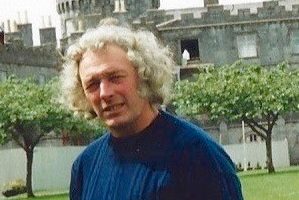
Introduction
Ted has been part of the village fabric for all of his life, and the village has definitely been a big part for Ted. Many people will have seen him around Rowlands Castle improving or repairing homes, roofs and gardens. However, behind the scenes Ted has been quietly archiving the lives of the people, their workplaces, buildings, schools and societies, which over the decades have created the village we know today. A small snapshot of this can be seen at Ted’s annual display of photographs and records at the summer fair.
Ted’s Family History
The Redsull name originates from Kent and if Ted’s grandfather’s decision to emigrate to Canada had come to fruition in 1910, the family would never have arrived in Rowlands Castle. However, on applying, Ted’s grandfather discovered that initial emigration was only for the man, the family only being allowed to follow at a later date. He wanted to keep his family together and so moved instead to Hollybank Farm, north of Emsworth, to work on a dairy farm and live in a tied cottage.
In 1914, despite technically being too old, he signed up as a special and aided the war effort for two years. This meant losing their tied cottage and the family moved to 12 Redhill Road in Rowlands Castle.
After the war he set up a ‘snobbing’ shop, a name locally used for a boot repairer, in his shed, having learnt cobbling in the army. The local council frowned upon working in an outhouse, so the family moved to 22 Redhill Road, which had a proper shop front. (This shop sold and repaired televisions in the later 1900s). It is interesting to note that originally house numbers were only used on the north side of Redhill Road, the houses on the south having names only. This was changed to the current numbering system in 1953. The Redsull family had four boys and a girl and Fred, Ted Redsull’s father, was born in 1910. He started school in 1916 in the old building, opposite the church at the top of Redhill Road (now a house). This was the school for those living in Redhill, designated part of north Havant at that time. (Children living in Rowlands Castle nearer the green went to the Idsworth school on the triangle at Magpies). He left school in 1923 and joined the gas company as a heating engineer. Ted’s mother was born in the East End of London and spent her holidays in a cottage at Magpies and from there met Fred Redsull. They were married in 1937 and moved into Aldwick, 38 Castle Road. Between 1940 and 1948 they had five children, three boys and two girls and Ted was born in 1943. Post war in 1948 the family moved to 24 Castle Road – a new Airey house. (These were designed by Sir Edwin Airey. They had prefabricated concrete columns reinforced with tubing recycled from old canvas tilt frames from military trucks. They were supposed to last 50 years but are fortunately still standing).
Growing Up and Schooling
Ted’s father tended an allotment (now The Fairway), and Ted got pocket money for helping daily light and look after the gas streetlamps on The Green and the one or two in Links Lane and Bowes Hill. This finished in 1950. In 1948 Ted started at Rowlands Castle school under the watchful eye of his teacher Daisy Baker. Childhood was spent collecting butterflies, bird eggs and often playing football on the fairway of the then 17th hole of the golf course, just behind his house. There was always a new football each Christmas and 25 a side football sometimes took place on the “rec”. The current St. John’s School is on the site of the church’s playing fields and football matches against St. Faiths and St. James were played there. Fishing was popular at the upper pond in Havant thicket and in the ponds of the brickyard. The works siren summoning the boys home, hopefully in time for their mealtimes. An outdoor childhood rarely enjoyed today. In 1954, at the age of 11, Ted started at Warblington school. There was a school bus, but occasionally Ted, and his friends, would “miss” the bus and walk to school by a convoluted route often not arriving until 11 o’clock! There was a lot of sport. Football again featured as well as the hundred-yard sprint.
Working Life
In 1959, having left school, whilst messing about with a friend in a scrapyard at Finchdean, Ted was asked if he wanted a job. This was part of Phillips Finchdean Ironworks, which also ran a garage, with petrol pumps. (Ted apparently was taken on in preference to his friend because he swept underneath objects while the friend just swept around them). The Ironworks at that time had a contract with Rowlands Castle brickyard to make stillages (mobile racks to move and store bricks). These were fabricated from old bedsteads acquired from Pounds Yard in Portsmouth. (Alongside what is now the M275 ). Ted helped to deliver these stillages to the brickyard, where he discovered his mates were earning three times what he earned. Thus, in 1960 he began his first stint working at the brickyard, although this was suffering financially and beginning to wind down, so Ted joined his father at Portsmouth Corporation in Dunsbury Way where he began to learn his skills. After his father died in 1962 Ted returned to the brickyard in Rowlands Castle, but soon left to join Powell and Lillywhite, where he learnt carpentry and building work and, over the next few years helped to build Tesco’s in Waterlooville and the Boots shops in Petersfield and Waterlooville. Later Percy Powell bought the struggling Whichers Gate Garage and Ted started working on the hot and arduous work of remoulding and retreading tyres.
Music
In 1963 Ted’s friends had started a band and after six months Ted joined them, having acquired a Vox Continental keyboard (as used by The Tornados!). The band then known as ‘Chris Cody’s Rave-Ons’, had a rhythm, lead, keyboard, drums and singer line up and initially played church halls and weddings. A young admirer from Leigh Park called Marion came to see the band and rather liked the keyboard player!
The singer, Chris Jeffries, acquired a throat infection which nearly put paid to the band. Booked to play at a wedding, the band members went to apologise to the groom explaining that they would not be able to perform. However, the groom could sing and not only performed at his own wedding, but joined the band. They progressed to club bookings, starting late and playing well after midnight, prompting a change of name to the ‘Midnight Shift’. Their influences were the Dave Clark Five and the Animals and they played gigs at South Parade Pier (on the same night as The Ted Heath Band), Portsmouth Guildhall and various Brighton clubs. From there they would get home at 5am and the day job started at 7! Their last gig was at Stockbridge, but sadly virtually no-one turned up because chart band ‘The Troggs’ were performing down the road. It was decided to call it a day, especially as for Ted marriage to Marion was pending! Ted and Marion married in 1968 in St. John’s Church, Rowlands Castle. They had their four boys, Mark, Matthew, Emerson and Greg and they finally outgrew their houses in Castle Road and Durrants Road and moved to a larger house in Bedhampton. Sadly, Marion died in 2014 after a long illness.
Self-Employment
Ted, having learnt his skills in the building trade, decided to go self-employed in the late 1970s much to the benefit of the residents of the village, who quickly discovered his boundless abilities, repairing and rebuilding their properties in his unique way. (Even going with them to work on projects in Brighton, London, Devon and even further afield to Ireland and France).
Motorbikes
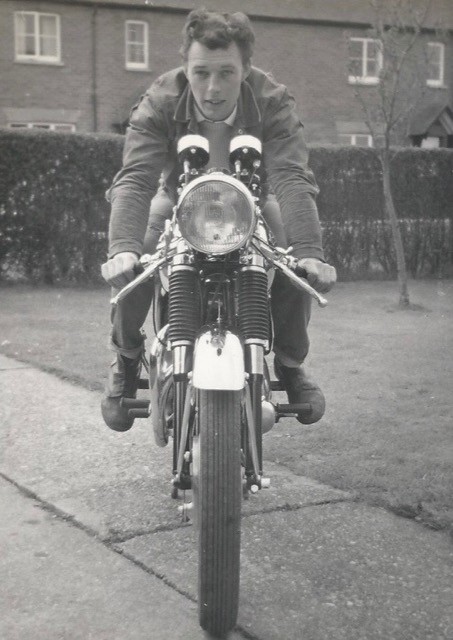
Motorbikes have always featured heavily in Ted’s life. The first and simplest was a Raleigh moped acquired to get to work in Finchdean. Other lads had motorcycles and scooters and childhood memories watching bike burn ups six abreast down the Havant /Horndean road fired a desire for something more exciting. Ted persuaded his dad, who had had a motorbike and sidecar, to give him a loan to buy an SS80 250cc bike from Percy Kiln’s motorbike shop in Southsea. He soon progressed to a Rocket Goldstar 650 twin. Ted learnt maintenance at home from his friends and still enjoys maintaining and riding 1960s bikes today. He still visits the Isle of Man each year with his family, taking a bike to explore the roads of the TT.
Dr Robert Palmer 1944 – 2022
Changes during 50 years in medicine
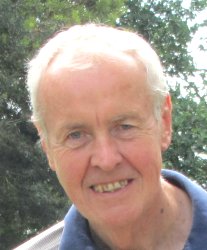
Introduction
Medicine has changed greatly in the last 56 years and I will attempt to record the important changes that I have experienced, in addition to personal recollections. I went to medical school (St Mary’s Hospital, London) in 1962. I started my clinical years as a medical student in early 1964 and worked until my 70th birthday in 2014.
As a student
When I was medical student a lot of medicine was like ornithology, you could spot things but there wasn’t a great deal you could do about it. That is most certainly no longer the case. At St Mary’s management of renal failure was in its infancy, dialysis and renal transplantation were just starting. I vividly remember an Oxford don in renal failure who died because he was over 30 (he was 31), and they only performed transplants on those under 30, inconceivable nowadays.
After qualification
When I did my house physician post at St Mary’s Hospital, Harrow Road in early 1968 the ward was full of men in their 60’s, mostly with advanced chronic bronchitis and emphysema (now called chronic obstructive pulmonary disease). Back then most men were heavy smokers and London had its smogs. We were not allowed to resuscitate any patient who had reached 70, again unthinkable today. After my house jobs I worked in hospital medicine, so this account will be primarily about the changes in hospital medicine that I have witnessed.
Early experiences as a young Doctor
After my house jobs I worked for six months in 1969 as a casualty officer in Kingston upon Thames. There was absolutely zero teaching or help from more senior doctors, and I well remember that after seeing the patient, and looking at the X ray if there was one, I would excuse myself and read up in a textbook in an adjoining room what to do next, not in front of the patient of course. I would hope and expect things to have changed for the better in this respect.
My next job in 1970 was anaesthetics in Westminster Hospital. On about my fifth day in anaesthetics as a complete novice I was with a consultant anaesthetist who happened to be president of the English anaesthetic faculty. He excused himself before the list started (probably he had a private case) and I had to do it by myself. It was a trans sphenoidal excision of a pituitary tumour (i.e. inside the brain) with a consultant ENT surgeon. How I didn’t kill the patient I will never know, and the terror lives with me still, and I nearly gave up anaesthetics then and there. I vowed that in no circumstances would I ever do the same thing with a trainee anaesthetist in the future.
Certainly, supervision of trainee surgeons and anaesthetists in the UK has improved markedly. I remember many instances when junior trainee surgeons were left to do cases by themselves inappropriately, with on occasion serious adverse consequences for the patient.
General Practice
During my career I have done general practice, as an addition to my junior hospital jobs. General practice is a very important field of medicine and it is not easy to be a first rate GP. Sadly it seems that the pressures on GPs nowadays are so much greater, with 10 minute appointments, targets to meet, the growing and ageing population, and the higher expectations of the general public and growing treatment options. Consequently, many doctors do not choose general practice as a career option any more, and if they do they tend to take early retirement. Also, the majority of medical students today are of the fair sex, which was certainly not the case when I was at medical school when it was much harder for ladies to be accepted and was certainly not a level playing field. Ladies tend to be more diligent students, they are articulate and interview well, they mature earlier and of course are better looking. However, in general practice and throughout medicine they are more likely to be part time, and of course their families are their first priority. This has a knock-on effect inevitably on availability of doctors for general practice and elsewhere.
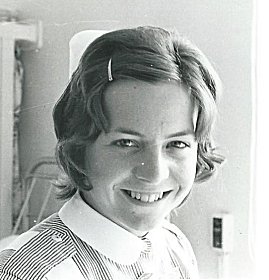
I remember when I was a Senior House Officer in maternity and paediatrics at St Richards in 1971 being invited by a Chichester GP to come and meet him and his partners. That was pure gold dust back then when GP jobs, especially in a place like Chichester, had very many applicants. Now sometimes they don’t have any applicants, even in places like Liss and Gosport.
I met my wife Valerie (above) in early 1972 when she was a student nurse at St Richard’s Hospital, Chichester, and poster girl for the hospital.

Having worked at Memorial Hospital, Worcester Massachusetts in North America for 14 years from 1976 to 1990 I have to say that supervision of juniors was always superior there to that in the UK. On that same theme another of my bugbears is that still in maternity units in the UK there is an absence of senior doctors out of hours, and this is in the most critical area of medicine. I remember over 40 years ago in the States there were always at least two attending (consultant) obstetricians and an attending anaesthesiologist in our maternity unit 24 hours every day of the year. That still cannot be said for UK units. Certainly it was much more the norm in the USA for senior doctors to be in the hospital out of hours, particularly in the acute specialties, with clear benefits for the patients. I enjoyed my years in the USA (Worcester, Massachusetts) and found Americans welcoming, hospitable and generous.
QA Hospital
After returning from America and two years working in Wales I came to QA Hospital Portsmouth for 22 years until my retirement in 2014. Below are experiences in the improvement in medical services I have witnessed.
Surgery
There has been significant progress for the better in the field of surgery. In orthopaedics in the 60’s total hip replacements were developed and in the 70’s arthroscopic surgery for knees and total knee replacements.
Similarly, laparoscopic surgery was a major step forward, particularly for gall bladder surgery and hernia repair, but more recently for major abdominal surgery and major urological surgery. I remember it coming into use widely in the late 80’s, and it is now pretty much the norm, with shorter recovery times.
An enormous development was phaco emulsification for cataract surgery in the 90’s. Cataract surgery used to involve a general anaesthetic, and a one-week hospital stay. Now it is an outpatient procedure with just eyedrops and taking 10 to 15 minutes.
Some operations are not being done any more, for example vagotomy and pyloroplasty for duodenal ulcer now treated with antibiotics, and tonsillectomy in children is much less common.
Another big change is that when I qualified; any lady below 28 weeks of pregnancy who lost the foetus was an abortion (miscarriage). This has been successively lowered to the current 24 weeks. Along with that has been the development of neonatal intensive care units and neonatal ventilation. The results of this intervention are not always easy to predict and may lead to long term care which can be difficult for the family and expensive for the NHS. Also in vitro fertilisation which has resulted often in older mothers, more often multiple pregnancies, and more abnormalities. On the other hand, there are couples who are desperate for children. It is a difficult one and I have mixed feelings about it.
A big step forward is the development of intensive therapy units (ITU’s). When I started at QA there were 1, sometimes 2, intensivists. There are now 16 and counting. At the recent CQC visit to QA our unit was assessed as excellent. There is no doubt that patients are getting much better care when they are seriously ill compared with 50 plus years ago. The unit at QA was largely developed by Gary Smith (earlier Alex Larson) with great help from Bruce Taylor.
Two other major advances at QA are the cardiac unit, which will provide a consultant cardiologist to insert one or more stents if appropriate into the coronary arteries of a patient who has had a heart attack, immediately, and at any time of the day and night. This saves the heart muscle and enormously improves the outlook for the patient. There is similarly at QA a stroke unit to treat patients who have had a cerebral thrombosis or embolus, again with good effect.
The stroke unit at Southampton General is very advanced and if a patient with a thrombotic stroke can get there quickly after their stroke a catheter can be threaded from the femoral artery, through the heart and up into the brain and a small metallic net extruded beyond the tip of the catheter and envelop the clot and remove it, all done by a senior neurologist and radiologist (under xray control) and they can go home very quickly without paralysis.
Another advance are chronic pain units, though there is a tendency for these to be farmed out into the community.
Anaesthetics
My specialty, anaesthesia, became much safer with the advent of capnography monitors (which measure the carbon dioxide in exhaled air, confirm the correct placement of an endotracheal tube, and identify a disconnection in the circuit); and pulse oximeters which measure the degree of oxygenation of the patient. These were both introduced in the early 1980’s and dramatically reduced the number of anaesthetic disasters.
More recent Developments
Open heart surgery developed during my career. So now aortic and mitral valve replacements and coronary artery bypass procedures are common practice, and for the less fit balloon valvuloplasty for mitral stenosis and transcatheter aortic valve implantation for aortic stenosis are available. Complex cardiac operations for congenital heart disease and operations for other congenital disorders in the very young are also performed.
More recently robotic surgery has been introduced, with the surgeon operating the robot some distance away from the patient in the operating room. In the investigative field we have CT scans and MRI scans, and so it goes on. Advances in chemotherapy and radiotherapy have prolonged life in cancer cases and in some cases cured previously fatal cancers such as Hodgkin’s lymphoma and some leukaemia.
Screening has become widespread. Screening for bowel cancer (occult blood) is very successful, though screening for prostate and breast cancer has had more mixed results.
Of course, scrutiny of doctors with appraisals and revalidation together with continuing medical assessment to ensure they remain up to date is a major component of a doctor’s life. In a way it has almost gone too far, significantly impacting on time that could be spent on patient care.
In summary I have had a very fulfilling and interesting career in medicine. I always wanted to be a doctor, even my primary school reports give that as my career choice. I have not in any way been disappointed. I was particular pleased to have chosen anaesthetics which suited me very well. I worked until I was 70 because I enjoyed it. I had already decided not to go beyond 70 because with age there is inevitably a deterioration on all fronts, and in an acute specialty this is particularly critical. I did have a near miss at 69 (the patient was fine thank goodness) which reinforced my intention.
Family and other interests.
Robert Palmer is a retired anaesthetic consultant, working most recently in Queen Alexandra’s Hospital, Portsmouth. He moved with his wife and family to live in Rowlands Castle in 1993, with family and grandchildren now also living nearby. He has enjoyed playing tennis and can be frequently seen cycling in the village. He has also been a British Universities water polo player as a student, and a competitive masters swimmer in later life, and was three times national champion in his age group in the 200 metre backstroke, and co holder of an age group European record for the 4 by 200 metre freestyle relay. He currently contributes to the u3a History Group, cycle group, quiz group and poetry group in the village. He is also an ambassador for the charity CHASE Africa, and a member of population matters and of course duties for his 9 grandchildren. 5th June 2018.
James Cooper, 1958 –
Twenty two years at the helm as Director of the Stansted Park Foundation
My Background
During 1996, I was visiting my family who then lived on Hayling Island, when they took us for a visit to Stansted House. I was captivated when walking down the main avenue in front of the House. I was immediately attracted to it and felt that this was the kind of place that I would like to manage. As on my very first visit, I still see a magnificent house set in an extraordinary landscape.
My career up to that point had been to qualify in ‘Rural Land Management’ at Royal Agricultural University, Cirencester (established in 1845, as the first agricultural college in the English-speaking world). I qualified as a chartered surveyor in the rural sector.
I had already spent a year in Australia and had worked for the National Trust first in Cornwall, and later worked for fifteen years in Kent and East Sussex. With the National Trust I had become very involved in the ‘heritage sector’, including, for example, managing Chartwell – Winston Churchill’s home – Scotney Castle, and the ‘White Cliffs of Dover’. So, in 1997, I regarded it as a huge privilege to be offered an appointment as Director at Stansted Park Foundation.
Stansted Estate
The Stansted Estate has a long history going back to Norman times. It has changed family ownership many times and has been rebuilt, and rebuilt again after a fire in 1900. It has been visited by many monarchs over the years.
The Stansted Park Foundation is more recent, being set up in 1983 by Fredrick Ponsonby, the 10th Earl of Bessborough, who died 1993. The main reason for setting up the foundation as a charitable trust was because of insufficient capital funding to sustain the large estate.
The objects of the trust can be summarised to ‘preserve the estate in perpetuity’, and ‘provide public access, enjoyment and education’. In educational terms, an estate such as Stansted offers everything from archaeology to zoology.
The Chairman of the Trust is currently Myles Ponsonby, the 12th Earl of Bessborough – a cousin of Frederick, the 10th Earl who established the ‘Foundation’. The Board of Trustees meets quarterly and the seven trustees were closely involved with planning and direction.
My role as Director was to provide a management service to them, with my main aim to generate income to meet the charitable objects – in a way that was sympathetic to the landscape and historic elements of the estate.
Management of Stansted
By nature, the manager of such a large and diverse estate delegates many responsibilities. While I sometimes felt like ‘a Jack of All Trades but master of none’, I delegated to: a House Manager for the House and related spaces such as offices for commercial letting – some 20,000 square feet; a Head Forester for the ongoing conservation and management of the woodlands including adapting to ‘climate change’, as well as leasing agricultural land for farming; the Head Gardner for management of the grounds around the House and ; the Buildings Manager for buildings of all types – domestic and agricultural – right across the estate.
Challenges and Achievements
The challenges that I knew that I was addressing focussed largely on securing funding both to maintain and then to improve the estate and its buildings for contemporary use. I am proud to have increased revenues six-fold during my twenty-two-year tenure.
It was generally agreed that the House was considered sacrosanct and that any changes were highly sensitive developments, and that other commercial developments should be ‘within the character of the place’.
The Walled Garden and the Garden Centre attract huge numbers of visitors daily and were useful in taking visitor pressure off the House so that it did not become crowded. Considerable investment was put into visitor facilities so that the main car park doubled to over 300 spaces, required moving some 20,000 tons of soil.
The Farm Shop was also a major asset, built with timber from the estate, using traditional carpentry construction methods. In the Walled Garden, plans are under way to complete the restoration of the original glasshouses, using modern materials.
The Garden Centre was totally refurbished in my last year in office, to make it more attractive.
One of the elements that defines a successful estate is that it creates a sense of community or ‘family’ embracing all employees, volunteers and ‘Friends of Stansted’ (FoS), with the continuing historic involvement of members of the Ponsonby family, all of which provides a strong sense of ‘emotional ownership’ for the Estate, respecting its history.
The Foundation was keen to develop relationships with the neighbouring village of Rowlands Castle (which shares the same post code as the estate but is just over the border in Hampshire). Representatives of the Parish Council attend functions on the estate and one has a seat on the Committee of Friends of Stansted. Villagers continue to work on the estate and still provide volunteers for both the House and the gardens. There is also mutually beneficial co-operation including display of an iconic model railway during D-Day 1994, purchased by Rowlands Castle Heritage Centre and displayed in the House during the past three years.
Next Steps
With a big birthday imminent, after a short break including some sailing in Alaska, I am looking forward to new challenges mainly focussing on consultancy in the ‘Heritage Sector’.
As a family, we have just moved from a comfortable cottage on the Estate to a flint-laced Jacobean farmhouse in nearby Compton. This will continue to provide opportunities for sensitive refurbishment over several years!
Our three children have grown up on the estate and moving to Compton should allow us all to keep in touch with our many friends. We departed after a series of very pleasant ‘farewell’ events, for which we are all most grateful.
Editorial: James Cooper retains the copyright to this article. It is based on conversations with James, reviewed and approved by him. It was first entered onto the RCHC website in October 2019.
Dr John Harrison, 1961 –
Background
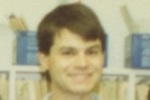
I started work in Rowlands Castle in 1987 as part of my GP training scheme. The background to me working in Rowlands Castle started very early on with wanting to become a GP from the age of around 10. ‘Why?’ people would ask me – this is still an impossible question to answer. Schooling was at the Brighton, Hove and Sussex Grammar school. From there I went to Leeds University to study Medicine.
Once qualified I worked in hospitals in Yorkshire and Humberside doing a variety of jobs; Medicine, General surgery, Accident and Emergency, orthopaedics, infectious diseases, Obstetrics and Gynaecology. At this time, I did give some consideration to Orthopaedics as a career choice, and as many know, my fascination with bones and sports injuries persisted through my GP career.
By now I had spent some years ‘up north‘, and had also developed some strong ties with the area having met my future wife Gill whilst I was still a medical student. Gill was a student nurse training in Leeds – home for her was Bury in Lancashire. I was missing the south coast, its weather and the sea. It was decision time as to where to do my year’s GP training. We decided to try and move south. At that time general practice was an extremely popular choice for Doctors and training places were highly contested, especially when trying to move areas. Fortunately, my interview technique worked and in 1987 I was offered a year’s GP training contract at Rowlands Castle Surgery. In those days Dr’s Ashworth and Drew were the partners – the surgery was situated in the building between what is now the Castle Stores and the Hardware store. Gill, who by this time had become my wife, moved down a few months ahead of me as she had secured a job on the neurological unit in what was then known as Southampton General Hospital. We bought our first house and lived in Emsworth.
Training for General Practice
I commenced as a GP trainee in August 1987. Dr Ashworth was in the process of retiring and his new partner was to start work in the practice a week after my arrival. Having settled into the area and discovering what a lovely community it was with the South Downs and the Solent so close by, it seemed I had missed a golden opportunity to work long term in Rowlands Castle. I started exploring long term partnerships close by. Then, somewhat surprisingly, the new partner announced his departure – it appeared that general practice was perhaps not what he wanted to do. This was very fortuitous for me. So, I applied for the partnership along with several others and was lucky enough to be successful at interview. This was the start of a long and happy career.
Life in Rowlands Castle
I was now a partner! I was suddenly discovering the additional responsibilities – decisions were now very firmly my problem! In those days, while we were responsible for a small list of under 3000 people, work wasn’t too pressured. In those days we were responsible 24 hours/7 days a week which meant being on call alternate days and weekends. As it was before mobile phones, this made simple tasks difficult. By default, my wife Gill, became the telephone answer service. This was additionally challenging for her as she worked shifts. By this time, however, she had secured a job closer to home as Sister in the intensive care unit at Queen Alexandra Hospital.
The early 90’s marked the arrival of our first child – doing visits was now even more interesting! Then on weekend visits my daughter was sometimes involved in coming on house calls – medical bag in one hand, daughter in car seat in the other. Maybe this early exposure to patients explains her decision also to qualify as a doctor?
The arrival of our practice mobile phone helped – It was the size of two house-bricks. But there were a few complaints from some patients about the cost of calling the doctor, despite the improvement in being able to speak promptly to him. Sometimes you just can’t win!! Maybe it’s something the NHS may reintroduce as an improvement as the cost of the call was a deterrent to some of the more minor ailment patients!
The mobile phone arrived around the same time as our second child! This time a son. I remember pushing the pram round with the phone in the basket at the bottom of the pram! At the time is was very liberating to be able to leave the house and the land line whilst ‘on call’. Because we were on call 24/7 it was a pre-requisite that you lived close to the practice, and by this time we had moved to a bigger house in Horndean, right on the edge of our area.
I was trying not to mix work and social life, but with a young family and by moving to a new estate, I found my new neighbours converting to become new patients – an unexpected ‘bonus!’ This wasn’t such a problem as I had perhaps originally anticipated, so when my enlarging family needed a larger house, I had no concerns moving into the village. We moved in, and our third child – another son – was born in 1995. The interesting thing here though, was that when I was in the consulting room I could often ask patients how they were – with a response of ‘I’m fine’, but crossing the road to the hardware store the reply could be ‘those tablets you gave me doctor!’ I’m not best known for my ability to remember names let alone what new tablets I may have started patients on, so this response always made me chuckle to myself! Even more interesting is when a patient starts a consultation whilst I have a beer in my hand at the pub amongst friends on a Friday evening!
Personal Development
As the practice at that time was still small, additional work was necessary. Within weeks of starting as a partner, a job in fracture clinic at QA Hospital became available and my orthopaedic career restarted! Having another role was beneficial generally. Doing a GP surgery is very isolating as there is rarely discussion with other clinicians when consulting. In my hospital role there was continual interaction making my working week much more interesting, and of course gaining additional clinical skills to the benefit of the practice’s patients.
The theme of other roles continued throughout my career with the following roles coming and going over the years:
- Vasectomy surgeon
- Local medical committee member
- Advisor to the then Portsmouth Health authority for Audit, a role to lead the local practices to improve quality
- GP member representing small practices for the local drug formulary
- Responsible for setting up/taking the GP lead for the Portsmouth area – – GP lead orthopaedic outpatients, which cut waiting lists dramatically for upper limb orthopaedic access to Queen Alexandra Hospital
- Director of the local GP Alliance, allowing local practices as a large organisation to bid for and run services that individually we were too small to organise and run.
Teamwork
Over the years I have been very lucky to work with a great team, and it is to this that I ascribe the smooth running and efficient service that the practice has delivered over the years. The fantastic teams of receptionists, nurses and administrative team slowly changed and grew over the years. Our receptionist team we have always kept small and compact as patients like a familiar face, with numbers increasing from three to four over the years. When I first started, we had just appointed our first part-time practice nurse – Sister Isobel Jones – a very rare skill in those days, later increasing to two nurses to give full time nursing. The administrative team saw the biggest changes, again initially a part time manager, this increasing to full time, with two part time assistants who also helped with ensuring the phones were answered promptly. Doctor numbers remained constant with two partners and a part time lady doctor, though the work pressures increased significantly over the years, along with the hours worked.
NHS ‘Changes and Challenges’
It has to be said that life would be boring without them! When I started, the practice had one computer, and little knowledge of what to use it for. All major illnesses were on a card-based system so there was no easy way to find how well we were doing in any area. As the trainee doctor, I made it my job to get some simple health data on it so that we had knowledge of the percentage of ladies with up to date smears, for example. This was more challenging than it would appear as the computer was guarded by a ‘dragon’ receptionist! We were an early adopter of many technological developments, from being the first to have a fax machine – so early we had no hospitals to fax – to being very early adopters of computerised records, so much so that, again, some 8 years after we had abandoned hand writing consultations, the NHS visited the surgery to certify us able to record consultations electronically.
Medical Changes
Medicine similarly has changed significantly; home births with the GP attending still occurred – it has been lovely in some of these deliveries to see them more recently, marry and have children of their own. Minor surgery was for a significantly larger list of procedures than is now allowed.
As we were a rural area the practice was a dispensing practice. This was a great asset to village patients, but the vagaries of the NHS meant that patients near a pharmacy were not allowed to use the facility. Running the pharmacy in addition to the practice was an additional challenge.

Over the 30 years from 1987, the practice population has increased from 2900 to 4300. We moved to our current location on The Green in December 1990. In 2010 we opened the attached pharmacy. This again required a change in working practice. We now had the additional benefit of a pharmacist who rapidly became another source of advice to our patients both for medicine queries and for minor ailments.
Preparing for the Future
With my children now all grown up and two of them living abroad, it seemed a good time for me to increase my family-time as we now had to start travelling to Australia and Oslo to visit them! Although I have loved looking after my patients and have many as friends, I was also starting to feel more and more despondent with the persistent changing NHS politics. So, in 2018 I made the decision to stop clinical practice.
I am still involved with medicine, doing a small amount of work undertaking other GP’s appraisal (this is part of the revalidation system for doctors), and holding regular conversations with my daughter and her boyfriend, both of whom are currently training in local hospitals.
Though I have hung up my stethoscope and no longer do any clinical practice, I have recently taken up a ‘clinical lead’ role in a large inner-city practice helping them respond to change and improving efficiencies to their care provision.
Looking back over the last 31 years of working as a GP in the village, I consider myself very lucky and privileged to have both lived and worked in such a lovely area within such a wonderful community. Gill and I have no plans to move out of the village and I look forward to meeting my ex-patients.
I would like to think that Dr Brendon Hayes and his team, along with Nemesh and Kinali in the pharmacy, will continue to build on these years and, together, can enjoy the same experience and success that working in this great community has given to me.
Editorial: This article was written by Dr Harrison who retains the copyright. It was first included on the RCHC website in November 2019.
Lionel ‘Buster’ Crabb
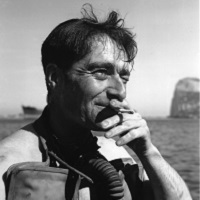
Lionel Kenneth Philip Crabb[1] OBE GM RNVR, 1909 – 1956
Resident of Rowlands Castle 1953 – 1956
Lionel ‘Buster’ Crabb was a WW2 diver and Commander in the Royal Navy who went missing on an unauthorised diving mission in Portsmouth Harbour to inspect a visiting Russian warship in April 1956. The subsequent government cover-up and media frenzy ensured his place in history and the extension of disclosure of information until 2056 has kept the mystery of his disappearance alive to the present day.
Early years and the Navy
Born in London on 28 January 1909, his father was declared missing in action during WW1 and he was taken in by his cousin’s family, Frank and Kitty Jarvis. His early life was fairly unconventional but he took an early interest in the sea. He tried to join the royal Navy at the outbreak of WW2 but failed due to his age (he was 30) and his colour blindness. He eventually managed to join the merchant navy as a carpenter and “somehow slipped into the Royal Navy”. In 1941 he joined the RNVR in Hove, Sussex and emerged as a Temporary Acting Probationary Sub-Lieutenant.
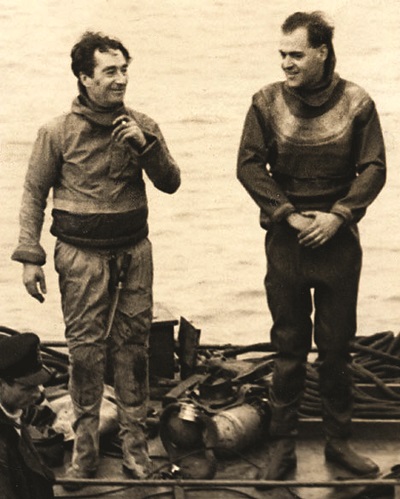
He found the training regime rather dull and applied for a voluntary job in a new top secret training unit dealing with unexploded ordnance. He attended the first course in HMS Volcano in Cumbria which led to a lifelong interest in explosives. He trained as a diver at HMS Vernon and HMS Excellent in Portsmouth after which he was transferred to Gibraltar working with a small team of divers searching for limpet mines on vessels’ hulls.
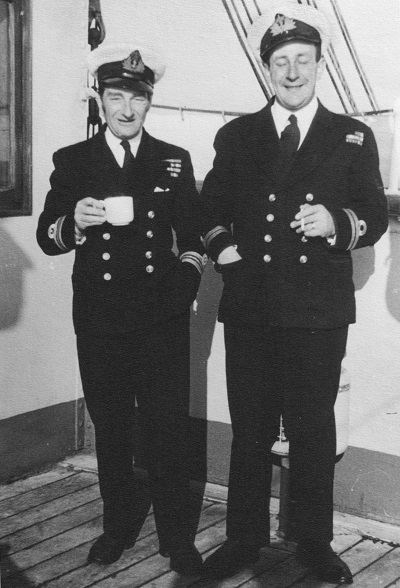
Just 5ft 6in tall, a feeble swimmer, chain smoker and heavy drinker, he was an unlikely diving hero. But he was totally fearless underwater with a remarkable ability to endure cold. While still only a temporary lieutenant in Gibraltar he was awarded a George Medal in 1943 for his hazardous work clearing mines. And two years later he received an OBE for his work clearing German mines from the ports at Venice and Livorno in Italy.
Crabb and Rowlands Castle
He was released from the Navy in 1949 but kept in touch with acquaintances and in 1951, he joined a diving team at UCWE (Underwater Countermeasures & Weapons Establishment) in Havant. 5 months later he married and moved into a caravan at the administration facilities in Leigh Park.
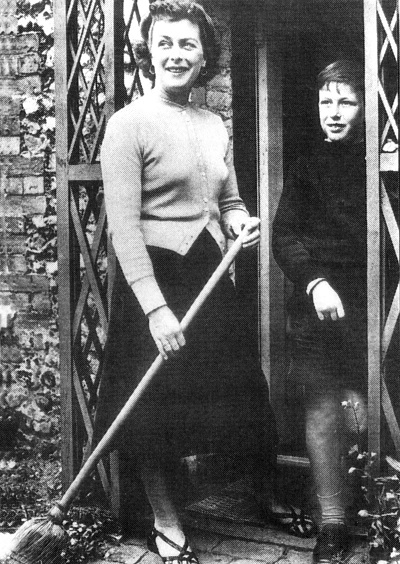
He was promoted to Commander in June of the same year and 7 months later, on 10 January 1953, he moved his small family* into Durrants Cottage, 45 Durrants Road, Rowlands Castle. (*his wife Margaret had a son from a previous marriage).
His ‘local’ was the Staunton Arms where he was known as a popular customer: he was a very heavy drinker. He and his team of divers would regularly occupy the snug for their lunchtime discussions. His marriage to Margaret Player lasted only 3 months after moving into Durrants Cottage.
Local residents, Mr and Mrs Benfield helped to look after his cat while he was away, but he had few friends elsewhere – he had a poor reputation with local retailers for not paying his bills.
Mysterious disappearance
Commander Crabb was retired from UCWE on 8 April 1955 but his name was kept on a list of ‘useful’ people for potential future projects. He moved to a bedsit in London but found adjusting to civvy street very difficult. So when he was approached by MI6 in 1956 to carry out an underwater survey of a visiting Russian warship, he was eager to accept the job; he was to be paid £100 (a significant sum at the time) which would help pay off some of his debts and it was a chance to renew acquaintances with drinking buddies in Portsmouth.
The job was to inspect the hull of a visiting Russian battleship that was bringing the Russian Premier (Bulganin) and First Secretary (Kruschev) on a diplomatic mission to Great Britain. 24 hours before the arrival of the delegation, the Prime Minister Anthony Eden forbade any interference with the vessels. Whether MI6 did not get the message or chose to ignore it, Crabb was brought to Portsmouth Harbour and prepared to carry out the dive. His first dive was unsuccessful; and on his second dive, he failed to return.
Due to the subsequent government cover-up the media took exceptional interest in the case and with all routes to the truth blocked, speculation thrived on what happened to Commander Crabb. A large number of theories and books have been written on the subject, each proposing very different solutions.
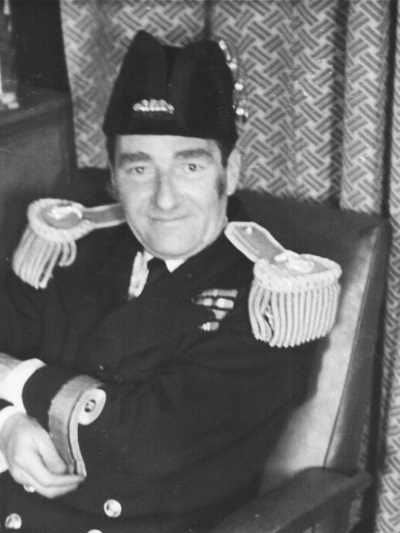
Information was due to be released 50 years after the event, but instead the release date was extended for another 50 years.
As a result, Commander Lionel ‘Buster’ Crabb, known to his friends as ‘Crabbie’, became one of the most famous of local men. And the whole truth of his mission and disappearance remains unresolved to this day.
The Blue Plaque
On January 28th 2023, on what would have been Crabb’s 114th birthday, a plaque was unveiled on Durrants Cottage, commemorating his years as a resident of Rowlands Castle.
Ann Bevan, January 2023
The diving museum in Gosport has Crabb’s medals and personal items on display. Ann’s husband John Bevan has written a book about Crabb, entitled “Crabbgate”. Visit this link for a contemporary report on the affair: Commander Crabb Mystery (1956)
Ralph Cousins
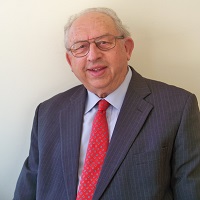
I started life as a potential historian having been born in Waterloo Road, Havant, on 18 June 1937; the 122nd anniversary of the Battle of Waterloo. My grandfather came to Havant in the 1890s to work at Stallard’s parchment works in Homewell. He was from a family of parchment makers.
My mother was a member of the Outen family who had roots in Rowlands Castle going back to at least 1750; notably the family kept the Castle Inn for nearly 200 years. They took over the previously named White Hart Inn after the notorious smugglers’ event. They were also blacksmiths in the village.
Through living in Havant all of my life I have built up a knowledge of the history of the area and also collected old postcards. With these two assets I was persuaded to put together and publish, with the late Peter Rogers, the book Bygone Havant. This came as a surprise to me as, although I went to Churcher’s College, I was pretty useless at English and English Language.
A few years ago my granddaughter asked me to speak at her school about wartime Havant. As preparation for this I put together various notes that a friend helped me to make into a booklet that was printed by Park Community School’s printing unit. Following this I published a history of the railway in the Havant area. These were really the only two booklets I totally researched myself, all of the others, now over 100 titles, are the work of other local historians who have asked me to edit and publish.
They are all on the Havant Spring Museum web site, where they can be read and downloaded for free. In the last three years it has had over 12,000 hits that have generated many enquiries including a number from overseas.
Editorial: Should you wish to purchase one of Ralph’s publications, he can be contacted by email via the editor. This article was posted in February 2022.
Paul Marshman
I was born in Waterlooville in March 1947 and lived for my first two years in Finchdean. My family then moved to Uplands Road where I have lived ever since. I went to the village school and then Warblington where I gained GCE’s in History, Geography and English Literature. I have played a lot of cricket over the years, and am a Pompey football fan, being a fund raiser for them, particularly in the days when they were in serious financial trouble. I worked as a storekeeper for 14 years in Chichester, followed by 24 years in nearby New Lane, before taking early retirement. Since then I found that gardening gave me exercise and the fresh air that I wanted.
My interest in local history was stimulated by an exhibition in the Parish Hall in 1977, to mark the 25th anniversary of Queen Elizabeth’s reign. My interest grew so that by 1983 I had accumulated a lot of written material about the village history, and I was doing my own research in local records offices. I had also inherited some of the artefacts from the 1977 exhibition. Since 1977 there have been other similar exhibitions in years 1981, 1987, 1989 and 1994. Artefacts are still being presented and some of the smaller ones are on display in the Parish Hall along with written notes.
On one occasion, I arranged a speaker on ‘Smugglers’ for a fund-raising meeting in the Parish Hall, all of which lead myself and Mary Jane Lomer to set up the Rowlands Castle Historical Society in 1988. During subsequent years I also collected a photographic record of the Village, mostly postcards but also family and individual views. I take ‘snaps’ of today, and encourage interested villagers to do likewise, so that they can be viewed in the future.
I enrolled in some local history classes and, being editor of the RCA magazine, took advantage and inserted my own articles. In 1987, I wrote a history of St John’s Church to mark its 150th anniversary. So, some thirty years later, I have 40 box files of notes and articles (some of which are much prized originals), 15 or so photo albums, artefacts and lots of maps. Over the years, I have written the following booklets and articles:
History of St John’s Church 1987
The Fountain Inn 2011
Rowlands Castle in World War 2
50th Anniversary of D-Day 1994
Model Railway booklet 2016
St John’s School 2006
Rowlands Castle Timeline for my Work
Mark Seaman
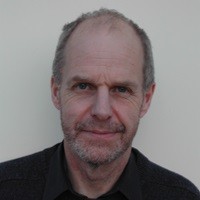
We moved to College Close, Rowlands Castle in 1989 where we have brought up our two sons. My interest in archaeology goes back to my childhood when I used to explore my grandfather’s farm which happened to cover “Venta Icenorum” in Norfolk. This was rekindled in 2014 with the “Secrets of the High Woods” project in the South Downs National Park which used laser surveys to identify preserved archaeological features under the tree canopies of the local forests.
I have since joined the Chichester and District Archaeology Society and am currently its treasurer. I regularly give talks on local archaeology. I have since developed the ability to process the laser data (called Lidar) myself. Using this data together with old historic aerial imagery I have identified old tracks, settlements, burial mounds, Roman roads and enclosures in the local area. My main interests are prehistoric (Neolithic through to the Roman period) archaeology, remote sensing and geophysics. Projects I currently have on the go include trackways and settlements in Stansted Forest, the Roman road from Havant to Rowlands Castle and beyond, old Idsworth, a rare oval barrow, old routes across Chichester Harbour and the 18thC gardens at Stansted House.
Paper for a book: “Secrets of the High Woods – Revealing Hidden Landscapes”. Editorial: The etymology of LIDAR can be viewed on Wikipedia
Editorial: this article was first posted on the website in September 2019
Sonya Teale
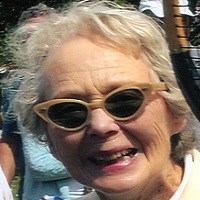
When I moved to the village in 1996, I joined Good Neighbours. I had much pleasure in driving Mrs Martin and Mrs Miles from Kings Close to the local shops and Post Office. They had been life-long friends from the day that they moved into Kings Close. Mrs Miles intrigued me with her stories of undertaking the village milk round after her husband volunteered for War Service.
Someone had to record these memories, I could not find anyone. I took advice from the Wessex Film and Sound Archive at Hampshire Record Office. Rowlands Castle Historical Society paid for a small but efficient recording machine and lapel microphone. I attended a couple of sessions on procedure for interviews at the Hampshire record Office in Winchester and the Head of Department, Dr Lee, was helpful with advice. I started recording in 2004. Wherever possible, I conducted the interview in my own home where I could ensure the minimum of background noise. There were no telephone sounds, no ticking clocks or noisy pets.
I started with standard questions on age, period of residence in the village, schooling and jobs. At the end of the interview I asked about their experience of D Day preparations, VE day celebrations and village societies and activities. I paused the tape whenever the interviewee signalled to me. Most of the interviewees relaxed and began to enjoy the telling. My role was to obtain the information with the minimum amount of my voice on tape. I also took a photo of the interviewee. The completed tape was sent to Hampshire Record Office where it was deposited and a copy sent to me to hold on behalf of the Historical Society.
What did I gain from these recordings? It was a great privilege to hear of the lives of local people. Off tape we had frequent laughter. I learnt of childhood escapades, wartime resourcefulness, sheer hard work, dances and plays at the Parish Hall.
It has been a humbling experience to learn of quiet, courageous lives contributing to the village. I have greatly enjoyed making the recordings. It pleases me greatly that Rowlands Castle Heritage Centre is making a transcription of the tapes available for others to read. Here are Sonya’s oral interviews.
Charles Rogers Cotton – Artist
Charles Rogers Cotton was born 2 June 1797 in the City of London, the son of William Cotton FSA (1759-1816) and Catherine Mary Cotton, née Savery (1769-1803). CR Cotton’s great grandfather (1711-1784) was an English customs officer and art collector. He was elected Fellow of the Society of Antiquaries London in 1752 and Fellow of the Royal Society in 1757. The art collection descended to CR Cotton’s father who sold it at auction in 1799 and 1801, realizing £3,886 10s.
CR Cotton married Ellen Matthewson (1804-1852) in 1827 they had 3 sons and 2 daughters. He appears to have become a Member of the Worshipful Company of Glovers of London before being admitted to the Freedom of the City of London in 1837. In the 1830s he entered, as a merchant cooper, into a partnership with Robert Owst, a wood hoop merchant at 6 Jacob’s Street, Dockhead, Bermondsey, moving to a nearby address in Bermondsey Wall in the 1840s. The partnership was dissolved in 1844. CR is described in the 1851 census as an annuitant, and in the following year, after the death of his wife, became one of the first Fellows of Stansted College in Rowlands Castle. While at the college he wrote A Visit to Rowlands Castle which was published in 1861. He was also an accomplished watercolour artist and painted many views around Rowlands Castle and district. He died at Rowlands Castle on 10 November 1878.
